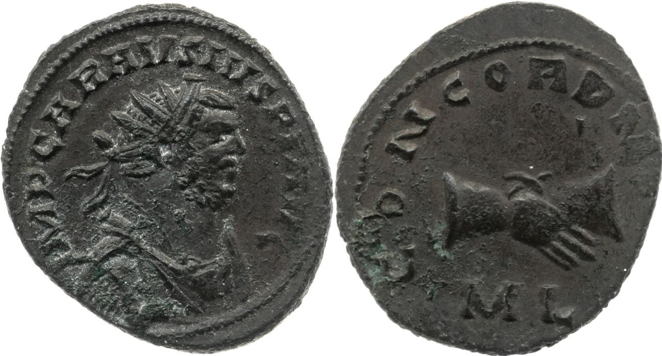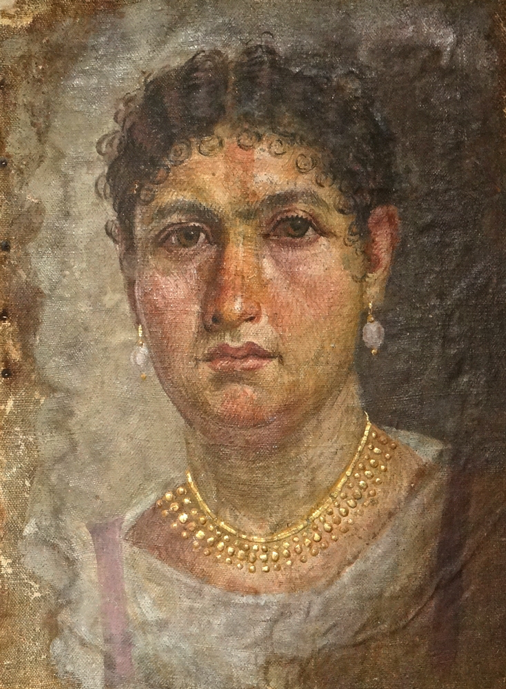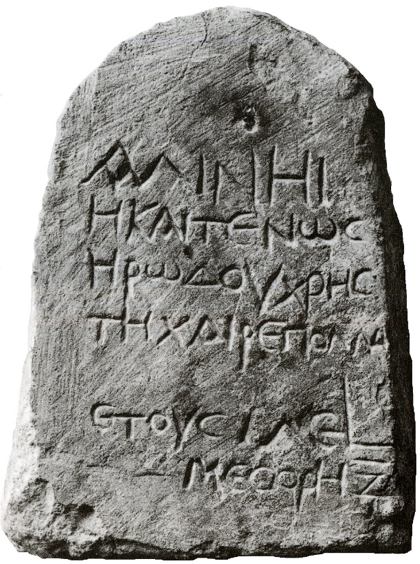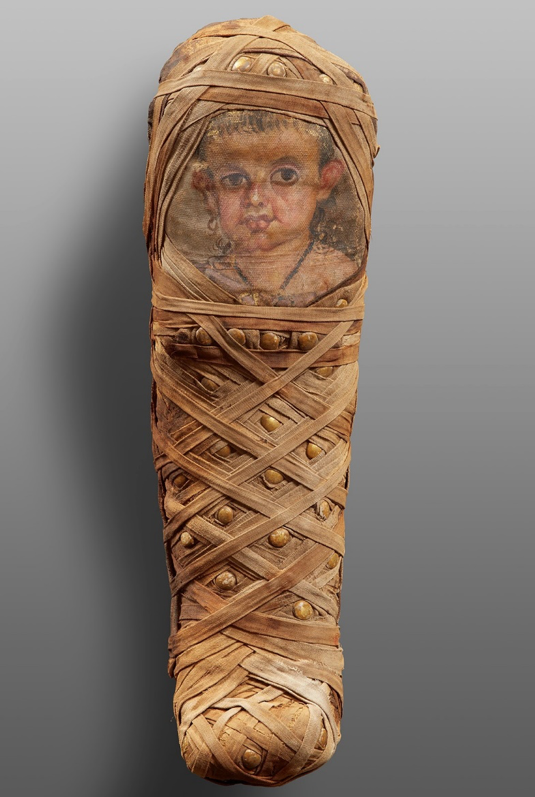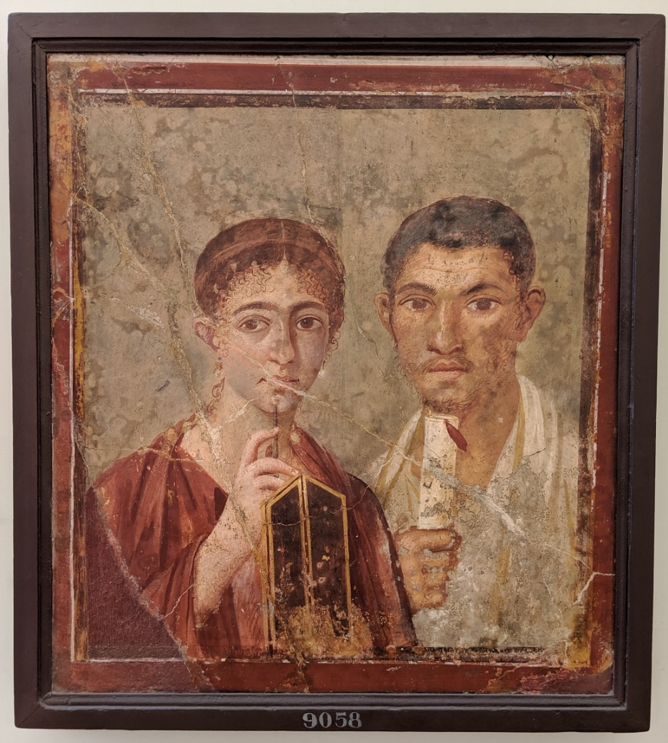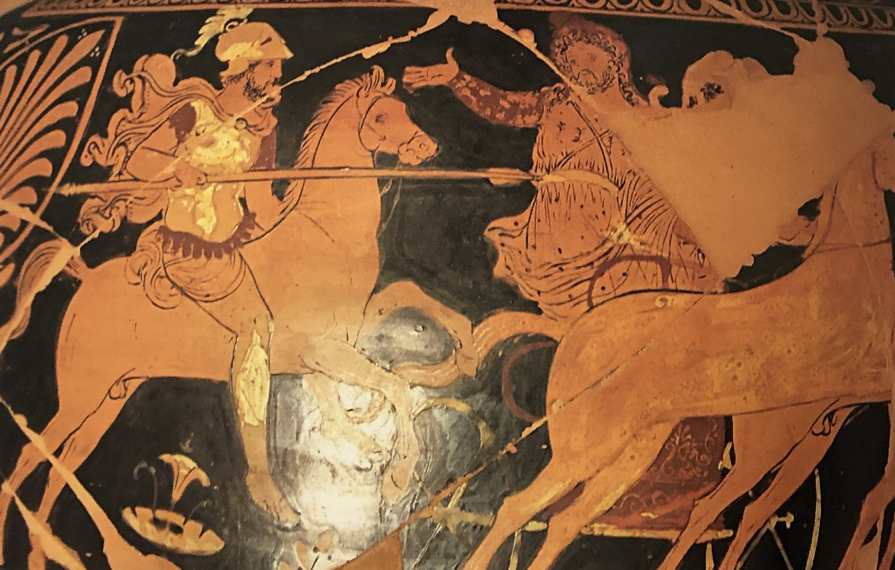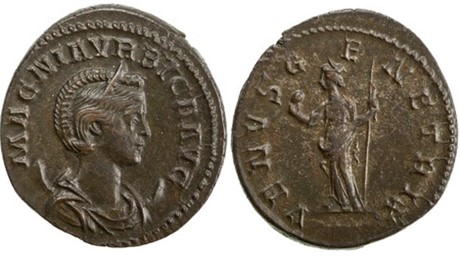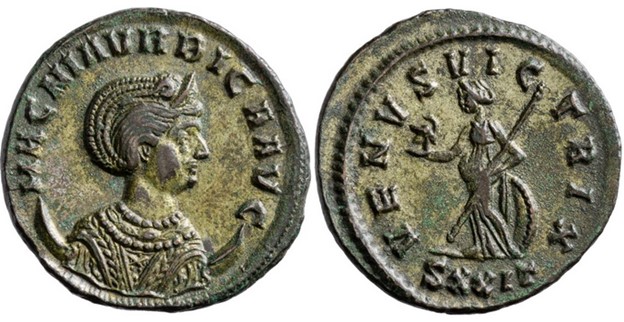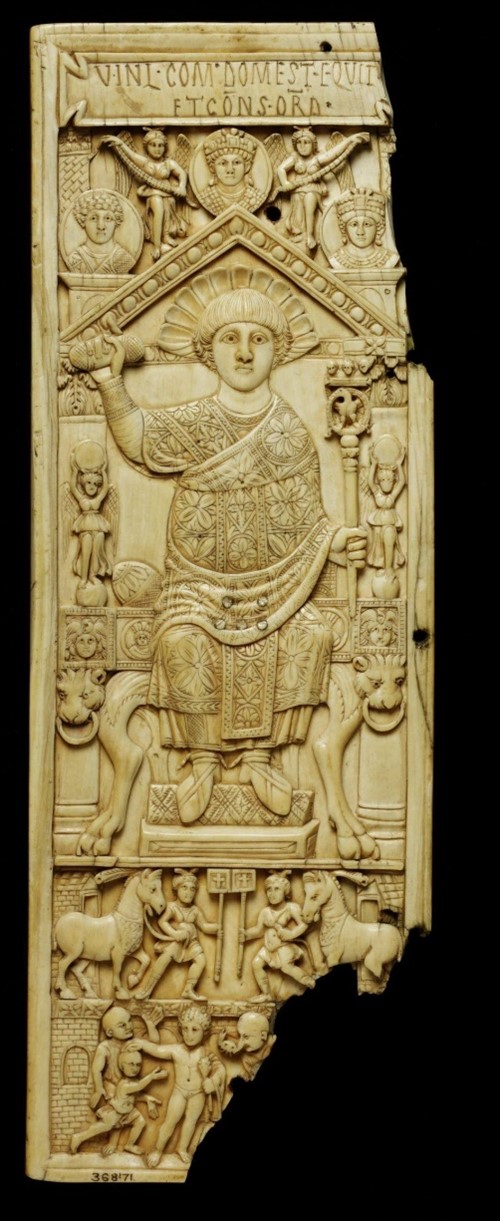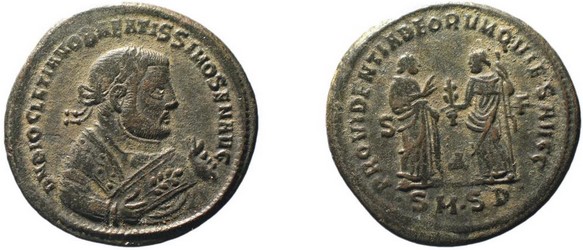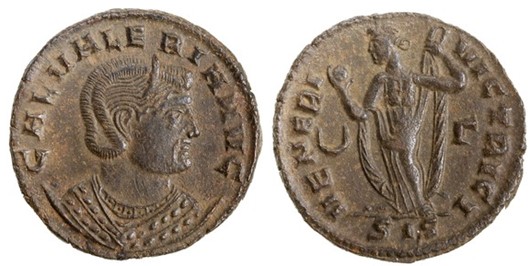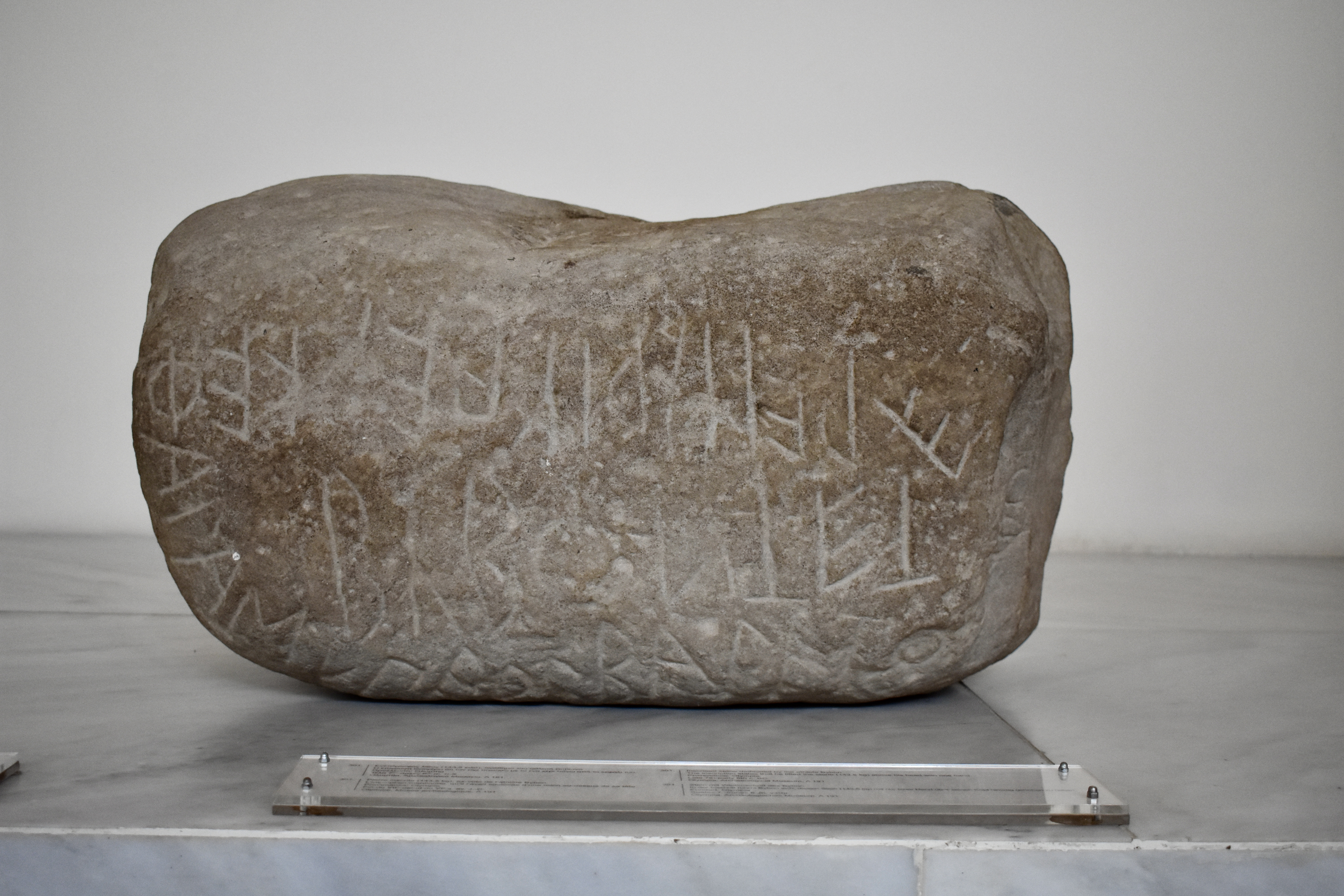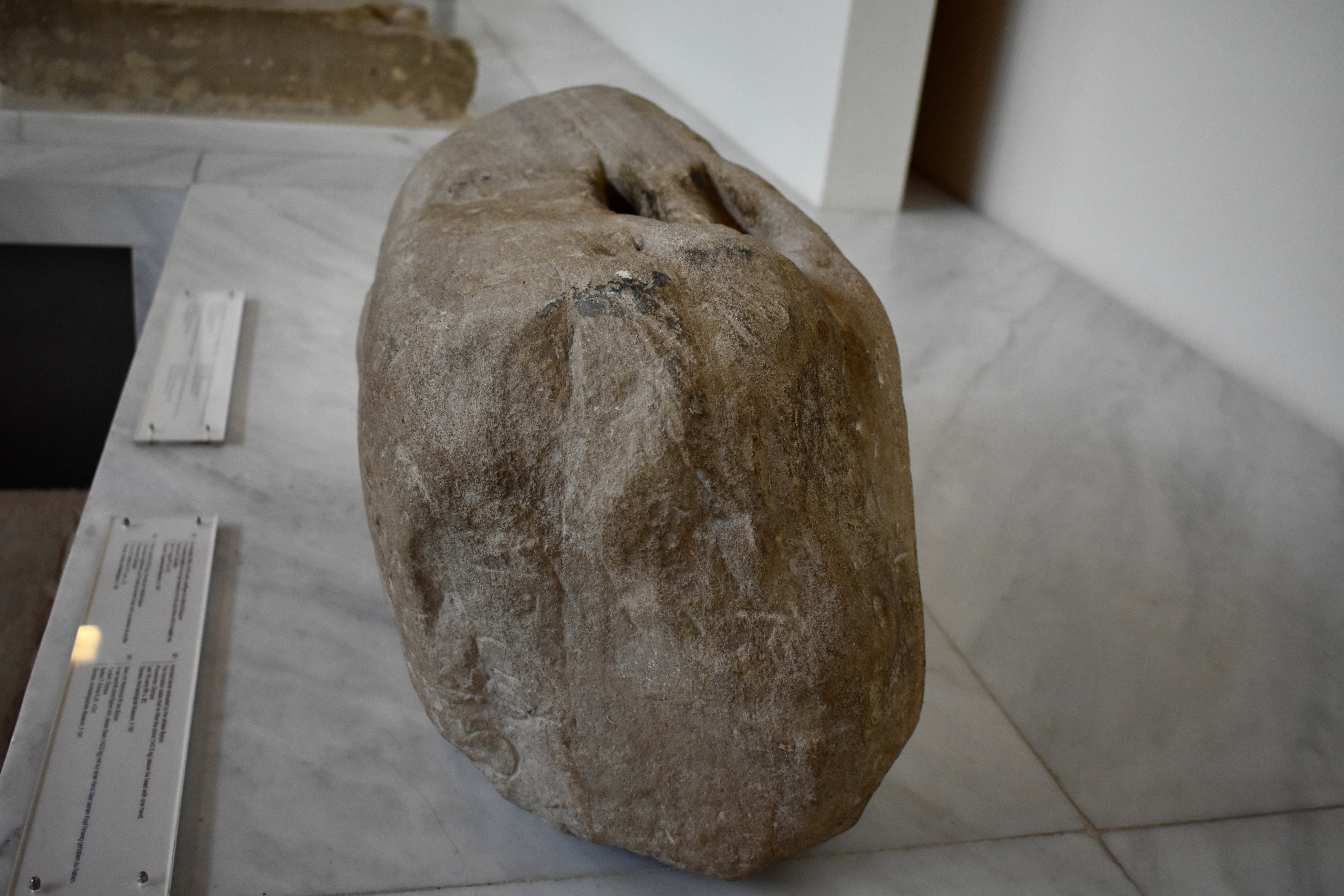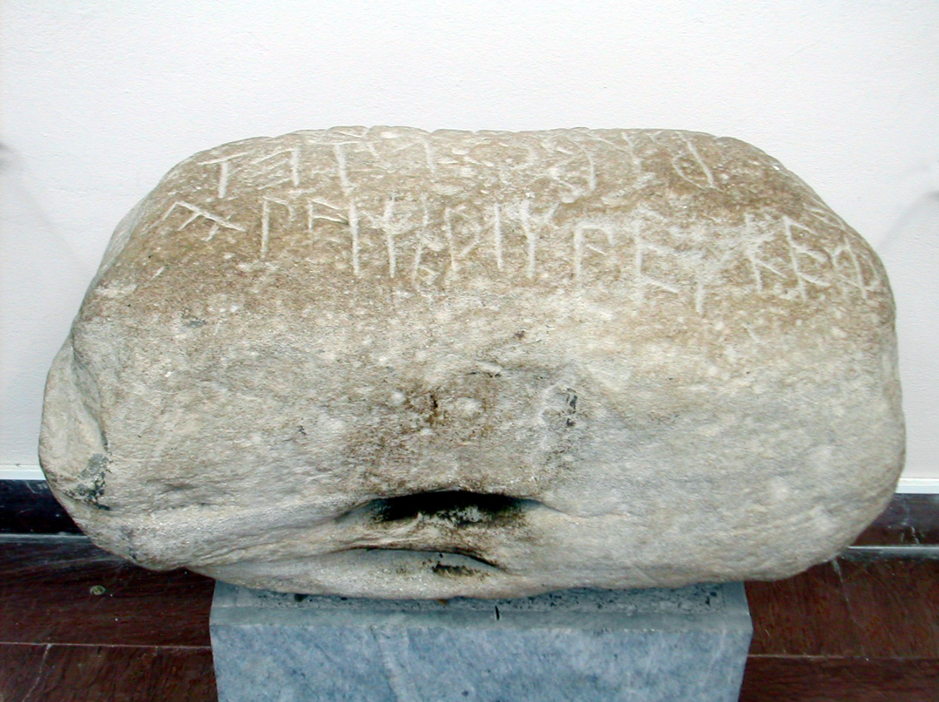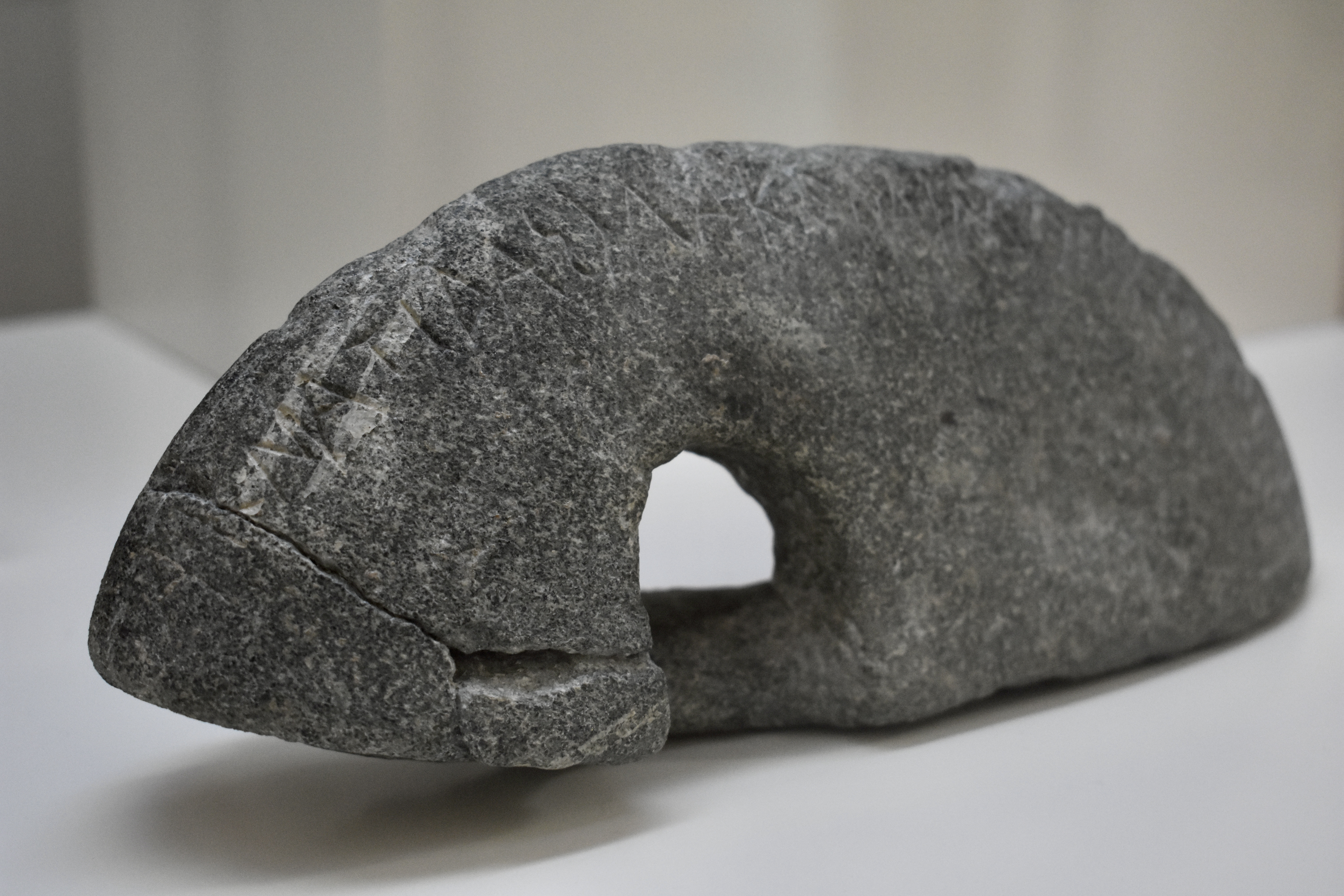2022

January - 'Dea Senuna – a goddess revealed' by Jacqui Butler
February - 'A rather bould(er) claim: inscribed rocks and weightlifting in the ancient world' by Matthew Evans
March - 'Antony's Legionary Denarii' by Campbell Orchard
April - 'Who’s that girl? A burial pithos from Thebes', by Dr Paul Grigsby
July - 'Precious boxes: the glitter of a new world' by Carlo Lualdi
August - 'Faces from the past – "Aline" and her children' by Jacqui Butler
September - 'The Arras Medallion: material evidence for reuniting a divided Roman Empire' by Giles Penman
October - 'Ismene in the wrong family? The tomb scene on the ‘Exeter vase’', by Danchen Zhang
November - 'Cuniculosa Celtiberia: rabbits as symbols of Spain on Roman imperial coins' by Abby Wall
Cuniculosa Celtiberia: rabbits as symbols of Spain on Roman imperial coins, by Abby Wall (Nov 2022)
Fig 1: RIC II, 3 (2nd) (Hadrian) 582-585, Aureus, Rome, 121-123 CE; courtesy of the British Museum.
I first encountered this beautiful aureus, minted at Rome between 121 and 123 CE, whilst conducting research for my MA dissertation. I was immediately struck by the unique composition on the reverse and, in particular, by the little rabbit it includes. The main figure in this scene can be confidently identified as Minerva, helmeted and holding her usual martial attribute of a spear. A rabbit, small but recognisable with its long ears and stocky body, stands at her feet. The final element of the scene, an olive tree, grows up from the ground behind the rabbit. The accompanying legend refers to Hadrian (76-138 CE), under whose authority the aureus was issued.
I was initially puzzled only by the inclusion of the rabbit; the olive tree could be explained away, however tenuously, as a second attribute of the goddess. Although the tree had never appeared alongside Minerva on Roman coinage before, the mythology of her Greek counterpart presents a potential link. Athena famously won the contest against Poseidon for patronage of Athens by offering an olive tree to the city’s founder. The rabbit, however, had never been associated with either Minerva or Athena. Was it added only for aesthetic purposes, to create a visually appealing rural scene? This seems unlikely as a rabbit had never appeared on the imperial coinage at all before this specific aureus. Surely its presence here must have some specific meaning. But what?
An answer may be found by examining some of Hadrian’s later coins where the rabbit appears once again, this time at the feet of a regional personification.
Fig 2: RIC II, 3 (2nd ed.) (Hadrian) 1529-1532, Aureus, Rome, 130-133 CE; courtesy of the British Museum.
On this aureus, Hispania is depicted as a female figure, dressed in a long chiton and reclining against a pile of rocks. The rabbit sits at her feet, and she holds in her right hand a large olive branch. To understand this personification, her attributes, and how they may be linked to those of the Minerva type we must situate both coins within the context of Hadrian’s reign.
Along with his enthusiasm for Greek culture and his infatuation with the young Antinous, Hadrian is perhaps best known for the extensive journeys he undertook throughout the Roman empire. Unlike previous emperors who preferred to leave Italy only when conflict required them to, Hadrian spent more than half of his twenty-one year reign touring the provinces. But being away from Rome for such extended periods of time made him unpopular with many of the capital’s inhabitants. Perhaps to explain his absences (or at least present them in a more favourable light) a series of coins was issued between 130 and 133 CE while he was away in the eastern provinces. Each of these types, sometimes referred to collectively as Hadrian’s ‘province’ series, depicts the personification of a place that had been honoured by an imperial visit.
The ‘province’ types can be subdivided into three categories: those showing the personification alone (Fig. 2), those showing the personification being raised up by the emperor (Fig. 3), and those showing the personification sacrificing upon his arrival (Fig. 4). Hispania and her olive branch feature in all three categories, but the rabbit is present in only the first two. Nevertheless, an association between the animal and the region is clearly indicated.
Fig 3: RIC II, 3 (2nd ed.) (Hadrian) 1584-1586, Denarius, Rome, 130-133 CE; courtesy of the British Museum.
Fig 4: RIC II, 3 (2nd ed.) (Hadrian) 1752-1756, Sestertius, Rome, 130-133 CE; courtesy of the British Museum.
It should be noted that ‘Hispania’ was not a single province. Upon Roman conquest, the Iberian Peninsula had been divided first into two and then three parts (Baetica, Lusitania, and Tarraconensis). This was mainly for administrative purposes, and the three provinces were often grouped together under the name Hispania. Representing the region as a female figure was not a Hadrianic invention; Hispania was personified on coins as early as 81 BCE, and she subsequently appeared on the imperial coinage of Galba, Vitellius, and Vespasian. On these earlier examples, however, she was never accompanied by a rabbit, nor did she hold an olive branch. So why do these attributes appear with Hadrian’s Hispania?
Ancient literature reveals that rabbits were commonly associated with the region. Varro describes a short-legged species of hare known as the cuniculus which was native only to Hispania (On Agriculture 3.12.6). He explains that the animal was given this name on account of its burrowing (cuniculus also meaning ‘mine’ or ‘underground tunnel’ in Latin). Hispanian rabbits were often considered pests for their fertility and the speed with which they could devastate crops. Pliny and Strabo report that rabbits were so prolific on the Balearic Islands that they caused a terrible famine, and the first writer additionally tells the tale of an entire city collapsing due to the animals burrowing beneath it (Pliny, Natural History, 8.81; Strabo, Geography, 3.2.6). These stories may be exaggerated (or indeed entirely fabricated) but they indicate that the rabbit was considered an iconic animal of Hispania, recognisable to many as a unique symbol of the region
As an attribute of Hispania personified, the rabbit may not have had exclusively negative connotations. Just as they are in modern times, rabbits were kept by the Romans both as pets and for their meat. Laurices, rabbit fetuses or newborns, were considered a culinary delicacy and, consequently, the animals were exported across the empire. It is also worth returning to the two definitions of the word cuniculus. Hispania was rich in valuable minerals, with abundant deposits of gold, silver, lead, and copper. Catullus describes the region as ‘cuniculosa Celtiberia’, which could be interpreted both as ‘Hispania full of mines’ and ‘Hispania full of rabbits’ (37.18). On Hadrian’s ‘province’ type, the animal may have had a similar dual meaning – one small symbol used to playfully acknowledge two resources provided by the province.
The olive branch held by Hadrian’s Hispania can also be explained as an important natural product of the region. Although olives were grown throughout the Mediterranean, Hispania was especially productive and Baetica in particular was famous for its olive oil, reportedly rivalling that of Athens! Furthermore, the branch may have had personal significance to the emperor himself. Both of Hadrian’s parents were born in Hispania, and his paternal line descended from the Aelii, a gens that had settled in the town of Italica in about 206 BCE. A wealthy family, the Aelii owed much of their prosperity to the olive plantations they owned in the area.
So, the choice of a rabbit and olive branch as representations or identifiers of Hispania on the ‘province’ types is understandable, but what of the rabbit and tree on the Minerva type? Given the rarity of the animal on Roman coinage overall and its exclusive use in combination with an olive branch on Hadrianic coins as attributes of the personified region, it seems highly likely that the earlier aureus also referred to Hispania in some way.
Hadrian was away in the West on his first provincial tour when the aureus was minted at Rome. After travelling through Germania, Britannia, and back through Gallia, he made his way to Hispania and spent the winter of 122/3 CE at Tarraco on the west coast of Tarraconensis. Perhaps a visit to his ancestral home was considered worthy of commemoration on the imperial coinage, although there is no record of him reaching his mother’s birthplace of Gades (modern Cádiz), and he pointedly did not visit Italica. Hadrian’s tour ended abruptly in 123 CE when a brewing war with Parthia called him away eastwards. The Minerva type may have been chosen to mark this departure and wish him good fortune as he sailed from a Hispanian port across the Mediterranean to face the Parthians. This is the explanation that I find most plausible, although both theories reinforce the idea that the rabbit and olive tree were present on the type as a reference to Hispania, the emperor’s presence there, and possibly his familial connection to the region. Overall, although the precise meaning of the Minerva aureus cannot be stated with absolute certainty, the floral and faunal components must surely refer to the Iberian Peninsula. If this is accepted, the type can be seen as an interesting precursor to Hadrian’s ‘province’ series, perhaps providing inspiration for the attributes chosen to clearly identify Hispania’s personification in later depictions (for example, Fig 5).
Fig 5: Marble statuette (height 27.30 cm) of a draped and veiled female figure, probably Hispania, with a basket resting on her knee; in the basket, a rabbit, 100-180 CE; courtesy of the British Museum.
Bibliography
Abdy, R. A. and Mittag, P. F. (2019) The Roman Imperial Coinage Vol. II – Part 3: Hadrian (London: Spink).
Ballester, X. and Quinn, R. (2002) ‘Cuniculus ‘Rabbit’ – A Celtic Etymology’, World Rabbit Science 10, 3: 125-9.
Birley, A. R. (1997) Hadrian: The Restless Emperor (London and New York: Routledge).
Birley, A. R. (2003) ‘Hadrian’s Travels’, in The Representation and Perception of Roman Imperial Power: proceedings of the Third Workshop of the International Network Impact of Empire (Roman Empire, c. 200 B.C. – A.D. 476), eds. L. De Blois, P. Erdkamp, O. Hekster, G. De Kleijn and S. Mols. (Amsterdam: Brill) 425-41.
Gnecchi, F. (1916) ‘Appunti di numismatica romana CXI e CXII. La fauna e la flora nei tipi monetali I. La fauna’, Rivista Italiana di Numismatica 29: 11-82.
Grey, C. (2016) ‘Hadrian the Traveler: Motifs and Expressions of Roman Imperial Power in the Vita Hadriani’, História 35: 1-20.
Imhoof-Blumer, F. and Keller, O. (1889) Tier- und Pflanzenbilder auf Münzen und Gemmen des klassischen Altertums (Leipzig: Druck und Verlag von H. G. Teubner).
Kitchell Jr., K. F. (2014) Animal in the Ancient World from A to Z (London and New York: Routledge).
Strack, P. L. (1933) Untersuchungen zur Römischen Reichsprägung des zweiten Jahrhunderts. Part 2. Die Reichsprägung zur Zeit des Hadrian (Stuttgart: W. Kohlhammer).
Toynbee, J. M. C. (1934) The Hadrianic School: A Chapter in the History of Greek Art (Cambridge: Cambridge University Press).
Toynbee, J. M. C. (1973) Animals in Roman Life & Art (London: Thames & Hudson).

This post was written by Abby Wall, an MPhil/PhD candidate in the Department of Classics and Ancient History at the University of Warwick. Abby's current research concerns the use of natural imagery as representations of people and places on Roman coinage of the late Republic to early Imperial period.
Ismene in the wrong family? The tomb scene on the ‘Exeter vase’, by Danchen Zhang (Oct 2022)
My interest in the theatrical space in the three ‘Electra’ plays by Aeschylus, Sophocles and Euripides led me to read about the representation of the homecoming and revenge of Orestes in vase paintings. This is how I came across an Attic red-figure pelike that presents an extremely intriguing case.Dating from 390-380 BCE, the pelike (Figures 1 and 2) was discovered in a cardboard box in the Royal Albert Museum in 1950 and is now held by the University of Exeter. On its front side, this vase depicts the tomb of Agamemnon (inscription [ΑΓ]ΑΜΕΜΝΟΝΟΣ on the base), which is decorated with funerary offerings. Among the figures surrounding it, the inscription ΗΛΕΚΤΡΑ above the head of the short-haired girl on the right side of the tomb clearly indicates that she is Electra. She holds her right hand in front of her face, and in her left hand she carries a hydria. She is followed by another girl with a similar hairstyle and gesture, who is presumably an attendant. Closer to the tomb, on the same side as the women carrying libations, sits a young man at the steps of the tomb. On the left side another young man, with a cloak and a petasos hanging on his back, is cutting his hair. They are easily identifiable as Orestes offering a lock of hair to his father’s tomb, and his companion Pylades. Above Orestes, another male figure is painted in a reclining pose, his position indicating that he might be a divine figure as he is relatively detached from the scene. On the far left is another female figure, facing towards the tomb and probably kneeling. Above her head there are faint traces of letters ΙΣΜ.
Ismene? Why would she appear in a scene where Agamemnon’s children are visiting his tomb? This interesting oddity is noticed by Brian Shefton, who first discovered this vase, but seems to be quite ignored by later discussions on the vase until recent years (LIMC Supplement Elektra I 1; Coo 2013). The scholars who address this inscription agree that the girl on the left side of the tomb should have been labeled as Chrysothemis, another daughter of Agamemnon, who appears in Sophocles’ Electra. The painter, however, confuses her with another mythological character, Ismene, the daughter of Oedipus and sister of Antigone, whom we also see in plays by Sophocles. Considering that the painting might have been informed by Sophoclean tragedy, it seems to be a likely mistake. In fact, Shefton calls it ‘one of those slips we are all liable to make’ (1982, 178): in Sophocles, the representations of the two pairs of sisters do have a number of things in common.
Both the story told in Sophocles’ Antigone and the one in his Electra concern the death of a close family member and the issues about mourning for the dead. In each case, the different decisions taken by the sisters reflect their distinctive personalities. In the Antigone, the issue of burial is presented at the beginning of the play as Antigone and Ismene debate about how to react towards Creon’s prohibition on the burial of Polyneices, who is their brother and at the same time one of the Argive leaders in the battle against his native city. While Ismene chooses to obey the order of the ruler, Antigone insists on honoring her brother and is later sentenced to death by Creon. The story in Sophocles’ Electra is set years after the death of Agamemnon, when Electra and Chrysothemis have both settled on their own ways of coping with the family disaster. Chrysothemis tends to yield under the power of Agamemnon’s murderers, Clytemnestra and Aigisthos, and therefore manages to live a more comfortable life in the house, while Electra indulges herself in a never-ending mourning for her father, longing for Orestes to return and take his vengeance. In both plays, Ismene and Chrysothemis have a similar dramatic role, as they are depicted as a weaker character compared to their defiant sisters. Sophocles’ characterization of the sisters is unique in extant tragedy. It may even be possible that there was a performance tradition that would represent both pairs of the sisters with different costumes, masks and hair, thus giving them opposite roles. Therefore, it is natural to think that the painter is informed by Sophocles’ plays, having the other pair of siblings in mind when working on the tomb scene involving Agamemnon’s children.
The details of the painting itself also seem to show the knowledge of the difference in the characters of the sisters. Electra’s hair is cropped, an indication of mourning, while 'Ismene’ has long hair and wears jewellery—differences in hair and dresses are also mentioned in Sophocles’ play (Electra, 359-64, 448-52). However, here on the vase, as Electra’s hydria indicates that she comes with a libation, ‘Ismene’ is also bringing her offering to the tomb. As Coo (2013) points out, the visible leaves between her and Orestes should have been part of the funerary wreath that she is offering to her dead father. Therefore, different from the popular iconography that depicts Chrysothemis merely as a weak figure fleeing from, or at least not participating in, the vengeance of Orestes (e. g. Figure 3), this vase shows the sister actively engaged with the mourning. This can reflect the painter’s more detailed understanding of the dramatic role of Ismene/Chrysothemis, as both ‘weaker’ sisters do sympathize with the heroines and try to support them. In the Antigone, Ismene shows her readiness to admit the burial and die with her sister, while in Sophocles’ Electra, Chrysothemis visits the tomb on behalf of Electra and returns with joyful excitement after seeing Orestes’ offerings.
Fig. 3 Chrysothemis (labeled, on the left) flees in fear, as Orestes about to kill Aigisthos, Attic red-figure pelike attributed to the Berlin Painter, 510-490 BCE, Kunsthistorisches Museum Wien (Image from Boardman 1975, fig. 143).
Indeed, Sophocles’ Electra never herself visits the tomb during the play. The play is set in front of the palace at Mycenae, and the tomb of Agamemnon is an off-stage place which the characters refer to verbally. Therefore, the painting of the tomb scene is of course not a ‘faithful’ depiction of any moment in Sophocles’ Electra. In fact, without particular attention to the ΙΣΜ[ΗΝΗ] inscription, this vase has been broadly thought to be related exclusively to Aeschylus’ Choephori, where the siblings Orestes and Electra reunite at Agamemnon’s tomb, and where the tomb is presented physically on stage. On the other hand, it is also common for vase paintings to depict off-stage scenes. During Sophocles’ play, Orestes, Pylades and Chrysothemis all leave the stage to visit the tomb of Agamemnon and re-enter with news or actions that shape the progress of the play. The tomb thus functions as a prominent conceptual presence throughout the play that is no less worth visualizing. Moreover, in an actual play, the stories would happen in a sequence: Orestes cuts his hair at Agamemnon’s tomb, before Chrysothemis comes to the tomb to decorate it, and Electra would reunite with her brother later in front of the palace. In this painting, different spaces and moments are brought together in the same composition. The painter is certainly not under any obligation to create a careful replica of a specific scene from Electra or Choephori. As a result, the viewers of the vase would also be able to appreciate the tension in this painting that recalls different crucial moments in the story, and even to make their own account of the curious presence of Ismene.
While the relationships between pots and plays are never straightforward, and it is hard to attribute this vase to a specific tragic scene, the interesting dynamic in this painting and the mislabelled sister make it certain that it draws on different tragic elements and merges together different stages of narrative. More than merely a forgivable slip made by the painter, it also reminds us about the various and 'slippery’ manners in which tragic performance and vase painting interact with each other.
Bibliography
Beazley, J. D., Attic red-figure vase-painters, 2nd edition (Oxford, 1963)
Boardman, J. Athenian red-figure vases, the archaic period (London 1975)
Boardman, J. Athenian red-figure vases, the classical period (London 1989)
Coo, L. ‘A Sophoclean slip: mistaken identity and tragic allusion on the Exeter pelike’, Bulletin of the Institute of Classical Studies, 56-1 (2013), 67-88.
Csapo, E. Actors and icons of the ancient theater (Chichester 2010)
Madsen, E. A., ‘Celebrating the pot-feast in the company of Aeschylus: an approach to an interpretation of the Exeter Pelike Beazley, ARV² 1516, 80. fig. 1A & B’, Classica et Mediaevalia 48 (1997) 53-73.
Shefton, B. ‘The krater from Baksy’, in The eye of Greece: studies in the art of Athens, eds D. Kurtz and B. Sparkes (Cambridge 1982) 149-81.
Taplin, O., Pots and plays: interaction between tragedy and Greek vase-painting of the fourth century B. C. (Los Angeles, 2007)
Trendall, A. D. and Webster, T. B. L., Illustrations of Greek drama (London 1971)
Wiseman, T. P., ‘Brian Shefton 1919-2012’, Pegasus 55 (2012), 48.
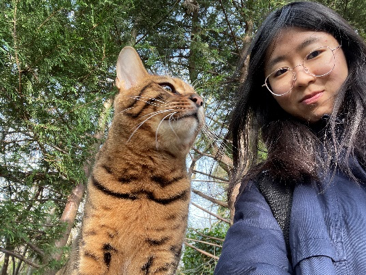
This blog was written by Danchen Zhang, PhD candidate in the Department of Classics and Ancient History at the University of Warwick. Her research interests are in the images and ideas of space and nature in Greek drama, and more specifically ‘winds’ in tragedy.
The Arras Medallion: material evidence for reuniting a divided Roman Empire, by Giles Penman (Sept 2022)
After being a province of the Roman Empire for hundreds of years since the emperor Claudius’ invasion in AD 43, a naval commander Marcus Aurelius Mausaeus Carausius led a rebellion in AD 286. Britain and northern Gaul became a separate state for a decade under his rule and that of his finance minister Allectus. The Arras Medallion (Fig. 1), dating from AD 297 is a rare visual depiction of the Roman successful counteroffensive by the emperor Constantius in AD 296. Together with the Panegyric of Constantius it is a key source for this successful military action.
Fig. 1: Constantius I, Trier, Arras Medallion, AD 297-305; RIC VI, p. 167, no. 34; BM. 11477.
Obv.: FL VAL CONSTANTIVS NOBIL CAES: legend surrounds bearded bust of Constantius I, r., laureate and draped, wearing a cuirass.
Rev.: REDDITOR LVCIS AETERNA /LON/PTR: legend surrounds scene of Constantius I on horseback riding r. beseeched by Londinium kneeling l. before fortified London; beneath personified Londinium ‘LON’; Beneath Constantius, sailors in ship on sea sailing l.; beneath sailors, ‘PTR’. AU 42mm 36g.
After distinguishing himself in Caesar Maximian’s campaign against the Bagaudae tribe in Gaul in early AD 286, Maximian appointed Carausius, a river pilot from the Menapii tribe in Belgae, north-eastern Gaul, as a military prefect in charge of the Roman naval fleet, the classis Britannica, based in Roman Boulogne, north-western Gaul. Maximian tasked Carausius with patrolling the Oceanus Britannicus or English Channel to suppress Frankish piracy. However, Carausius was accused of allowing the pirates to raid ships and then taking their spoils to enrich himself. Once he learnt that Maximian had ordered his execution, Carausius fled to Britain, revolted and occupied the province later that year. Britannia and Northern Gaul where Carausius soldiers were mainly based seceded from the Roman Empire for the next ten years.
Although historians know little about Carausius’ reign, Carausius minted coins in Londinium with legends and imagery suggesting that he was a legitimate emperor in Britain. For example, an Antoninianus coin (Fig. 2) depicts a bust of Carausius wearing a radiate crown and cuirass with a cloak. This depiction is strikingly similar to the coin depictions of the legitimate Roman emperor Diocletian who is frequently radiate, cuirassed and draped, see for example the aureus in Fig. 3. This presents Carausius as a militarily powerful imperial ruler who is the equal of Diocletian. Similarly, Carausius received and adapted the Diocletian legend ‘IMP C C VAL DIOCLETIANVS P F AVG’ to ‘IMP CARAUSIUS P F AVG’. Carausius appears as the rightful emperor of Britain who claimed the same imperial virtues of loyalty to the Roman state and piety as Diocletian, even though he was an illegitimate usurper of imperial authority. Carausius reigned until he was assassinated by Allectus, his finance minister, in AD 293. Around this time, Constantius, Maximian’s son and successor as Caesar, besieged Boulogne and began rebuilding the Roman fleet.
Fig. 2: Carausius, Londinium, Antoninianus, AD 286 – 293; RIC V, p. , no. 25; BM 1925,0316.157.
Obv.: IMP CARAVSIVS P F AVG: legend surrounds bust of Carausius, radiate, draped, cuirassed, r.
Rev.: CONCORD MILIT / ML: legend surrounds clasped hands; beneath hands, mint mark ML.
AR 4.18g
Fig. 3: Maximian, Lugdunum, aureus, AD 284-294; RIC V, p. , no. 3; BNF AF.1582 / IMP-10520.
Obv.: IMP C C VAL DIOCLETIANVS P F AVG: legend surrounds bust of Diocletian, laureate, draped, r.
Rev.: VICTORIA AVG: Victory, winged, draped, standing l., holding wreath in r. hand and palm in l.
AU 4.99g
Constantius’ invasion of Britain, depicted in brief on the medallion, took place in AD 296, for which the Panegyric of Constantius is the only historical literary source. The armies of Constantius under his praetorian prefect Asclepiodotus and other military leaders defeated Allectus and his army of mercenaries in bloody combat (Panegyric 8.16.3). After Allectus’ death in battle, his mercenaries knew they were no longer going to be paid. They began to loot London to make good their losses. Although lost in fog, Constantius’ men slaughtered the looters, saving the provincials. The massacre of the mercenaries, the Panegyric reports, gave the provincials a ‘pleasure of the spectacle’ (Panegyric 8.17). This suggests that the massacre itself was a pleasure for them to behold and that the mercenaries were taken prisoner and used as part of spectacles in the arena. Whatever their exact fate, Constantius’ armies defeated Allectus and brought the province of Britain back under legitimate Roman control.
The medallion’s imagery and legends emphasize the military power and achievements of Constantius. The reverse depicts Constantius on horseback riding to the defence of the personified Londinium. Dressed in a tunic and cuirass and holding a spear, Constantius appears heroic and gallant in his reclamation of Britain and defence of Londinium. The personified city kneels with arms aloft, begging Constantius for assistance lest she be destroyed by the looters. This underscores the desperation of Londinium and Britain in its time of need, and Constantius’ heroism for coming to her rescue. Although he almost certainly was not present in Britain for the invasion and main attack, entrusting leadership instead to his generals including Asclepiodotus, this image creates the impression that Constantius was present, personally led his armies and heroically defeated Allectus’ mercenaries. The reverse legend ‘REDDITOR LVCIS AETERNA’ or ‘the restorer of eternal light’ of Roman civilization to Britain verbalizes Constantius’ great achievement. Even though his soldiers and generals defeated Allectus and his mercenaries, this suggests that Constantius personally has restored Britain from the darkness of separatism to the light of Roman laws, religion and customs. As a restorer of a province, this places Constantius in an imperial tradition of provincial restoration which stretches back to the emperor Hadrian. Constantius appears as a virtuous emperor who has similar qualities to his great deceased predecessors. Indeed, the obverse legend ‘Nobilis Caes’ or ‘Noble Caesar’ reflects Constantius’ exemplary qualities. The obverse image further highlights Constantius’ accomplishment. He wears a laurel wreath, worn by triumphing Roman generals, emperors and their soldiers during a triumphal procession, awarded after a victorious military campaign. Together with a cuirass and cloak, this presents Constantius as a great military leader who achieved a substantial feat by reuniting Britain and northern Gallia with the Roman World and deserves victory spoils. Therefore, even though Constantius was not present at the invasion of Britain, the medallion suggests that he led his army heroically to re-unify Britain with the rest of the Roman Empire.
The deposition site and material of the medallion suggest that it formed part of imperial image creation for the Caesar and later emperor Constantius. The medallion was minted in Trier, northern Germany, but excavated in a coin horde in Beaurains, north-eastern France. Its presence in a horde hundreds of miles from its mint and its substantial weight suggest that medallion had a significant role in transmitting the message of Constantius’ victory in Britain across the Roman World. This emphasizes that the emperor Maximian wished the Roman people to consider Constantius to be a great Roman hero and conqueror who had unified the Roman world. Indeed, the medallion is made from gold, the equivalent in weight of 10 aurei. That the campaign warranted commemoration with a heavy gold medallion, requiring much expensive gold to mint and skill to create, portrays Constantius’ victory as a brilliant feat of arms. Therefore, the gold medallion deposited far from its place of striking shows that it was designed to transmit a significant message about imperial power to Roman citizens.
In conclusion, the naval commander Carausius revolted and occupied Britannia and northern Gaul. Despite being a usurper, he presented himself on locally produced coin legends and imagery as a legitimate imperial ruler, rivalling the emperor Diocletian and his subordinate Caesar Maximian. Allectus, Carausius’ finance minister assassinated him in AD 293. The Panegyric of Constantius is a key source along with the Arras Medallion for Constantius’ invasion. Constantius rebuilt the Roman fleet and invaded Britain in AD 297. The Arras Medallion’s imagery and legend emphasize Constantius’ heroism and gallant actions as the re-unifier of the Roman World and a principled ruler.
Abbreviations and Bibliography
Abbreviations
BM = British Museum.
BNF = Bibliothèque nationale de France, département Monnaies, médailles et antiques.
l. = left.
r. = right.
RIC V = Webb, P. H. (1933). The Roman Imperial Coinage Vol. V Part II (Vol. V ). (H. Mattingly, & E. Sydenham, Eds.) London: Spink and Son Ltd.
RIC VI = Sutherland, C. H. (1967). The Roman Imperial Coinage Vol. VI: Diocletian to Maximinus. London : Spink & Son.
Bibliography
Primary Sources
Ireland, S. (2008). Roman Britain: A Sourcebook. London: Routledge.
Sutherland, C. H. (1967). The Roman Imperial Coinage Vol. VI: Diocletian to Maximinus. London : Spink & Son.
The Trustees of the British Museum. (2022). 'Arras Medallion'. Retrieved September 16, 2022, from The British Museum: https://www.britishmuseum.org/collection/object/C_B-11477
The Roman Imperial Coinage Vol. V Part II (Vol. V ). (H. Mattingly, & E. Sydenham, Eds.) London: Spink and Son Ltd.
Secondary Sources
Beard, M. (2007). The Roman Triumph . Cambridge : Cambridge University Press.
Casey, P. J. (1994). Carausius and Allectus: The British Usurpers . London: B. T. Batsford Ltd.
Lyne, M. (2003). Some New Coin Types of Carausius and Allectus and the History of the British Provinces AD 286-296. The Numismatic Chronicle, 163, 147-168.
Nixon, C. E., & Saylor-Rodgers, B. (1994). VIII: Panegyricus of Constantius. In C. E. Nixon, & B. Saylor-Rodgers, In Praise of Later Roman Emperors: The Panegyrici Latini: Introduction, Translation, and Historical Commentary with the Latin Text of R. A. B. Mynors (pp. 104-144). Berkeley: University of California Press.
Southern, P. (2004). The Army in Late Roman Britain. In M. Todd (Ed.), A Companion to Roman Britain (pp. 393-408). Oxford: Blackwell Publishing Ltd.
Williams, H. (2004). Carausius: a consideration of the historical, archaeological and numismatic aspects of his reign (BAR British Series). Oxford: British Archaeological Reports Publishing.
This post was written by Giles Penman, who is a final year MPhil student in the Department of Classics and Ancient History, jointly supervised by the Department of History. His thesis concerns the reception of Greco-Roman imagery on British civic cultural artefacts of the Great War 1914-1918 and the Inter-War Period 1919-1938 to mobilise British people for the war effort and post-war commemoration.
Faces from the past – "Aline" and her children, by Jacqui Butler (Aug 2022)
The Fayum portraits from Roman Egypt which are dated to the first to third centuries AD, are amongst the most captivating and poignant artefacts to survive from the ancient world, providing us with visual representations of how the people beneath the mummy wrappings might have looked in life. The portraits are evocative memorials and can be quite moving, with the deceased often depicted looking directly out at the viewer, inviting engagement with their image. They are all the more valuable given the lack of painted portraiture which survives from antiquity, as although marble portraiture survives in quantity, allowing us a similar look at the features of the dead, these painted images are more realistic, more evocative, and more engaging.
The portraits appear on a variety of media and incorporate different techniques; some show whole figures whilst others depict only the head and face. Some are likely to have been painted in life and kept until the death of the subject, whilst others would have been painted posthumously. Many are very sophisticated and high-quality works of art, portraying their subjects in a naturalistic manner, likely reflecting a degree of Greek influence in this regard, whilst others are stylised in different ways or are much more simplistic. They are of course a product of the society which created them; rather than an amalgamation of Greek, Roman and other cultural influences, Egypt maintained much of its own cultural identity and customs alongside these. Mummification to preserve the physical form, which was considered essential for life after death was, of course, an Egyptian ritual religious practise, and the portraits can be understood to reflect a development in Egyptian funerary art. This unique addition of portraits to the mummies, which began during the reign of Tiberius (AD 14-37) often incorporated elements of Roman dress and adornment, reflecting this aspect of contemporaneous society in Egypt.
Fig. 1. “Mummy portrait of Aline”, Ägyptisches Museum, Staatliche Museen du Berlin, ID. No. AM 11411. Height: 42 cm; Width: 33cm; Depth: 2 cm. Creative Commons BY-NC-SA 4.0.
Fig. 2. “Stele with Greek inscription”, Ägyptisches Museum, Staatliche Museen du Berlin, ID. No. AM 11415. Height: 23 cm; Width: 16 cm. Now lost.
Inscription translated by J. Moje as “ Aline|aka Tenos| (daughter) of Herod, the good| Greetings!| 10th year of reign. 35 years of life| 7 Mesore”. Creative Commons BY-NC-SA 4.0.
The Roman era burial pit in which Aline’s mummy was found, was discovered at the end of March 1892, by Professor Richard von Kaufmann, a German art collector, who undertook a small excavation at Hawara in the Fayum. The pit dates to the first to second centuries CE, and contained eight mummies, two of which had gilded cartonnage masks, three with painted portraits and three others with no ornamentation. The burial pit has a shaft leading to it, about 1 metre deep, and the pit is 3.5 metres long and 2.8 metres wide. The mummies themselves were found stacked on top of each other: the mummy of Aline was at the bottom, lying on its side, with the mummies of two small children alongside her, and the inscribed stele at her head. Lying on top and across these, was the mummy of a man and a further child, both with the gilded masks, and on top of these, again laid cross-wise, were the three further undecorated mummies.
The mummy of both Aline and the man were unwrapped at the time of excavation in Hawara, with the gilded cartonnage mask of the man and portrait painting of Aline being transferred to Germany, together with the mummies of the three children. Somewhat gruesomely, the head of Aline’s mummy was removed (and is now lost) in order for a facial reconstruction to be created, to prove the similarity between the facial features of the mummy and the portrait. However, the facial features of her mummified head were not well preserved, and a reconstruction therefore proved difficult, although some similarity can be seen in a drawing taken from the head and superimposed onto another of the portrait.
Therefore, whether the mummy portrait of Aline was intended as a true likeness or whether it was an idealised portrait cannot be definitively verified. More likely it is a combination of the two, and a closer look at elements of Aline’s portrait, as well as the portraits of the two children may demonstrate this. All three of these portraits were painted directly onto the shrouds bound around the bodies and are lit from the right-hand side, which adds depth to the images. They share similarities in facial features, specifically in the shape of face and their lips, signifying their familial connection. It has been suggested that they were painted by the same artist, although Aline’s eyes are much more realistically depicted than those of the children. The jewellery Aline wears is highlighted by being painted in gold leaf on top of applied stucco, whilst the children’s mummies are decorated with similar button shapes (Figs. 3 and 4).
Fig. 3. “Mummy of a girl with mummy portrait (“Aline’s daughter”), Ägyptisches Museum, Staatliche Museen du Berlin, ID. No. AM 11412. Length: 83 cm; Width: 27 cm; Depth: 20 cm. Creative Commons BY-NC-SA 4.0.
Fig. 4. “Mummy of a Male Child with Mummy Portrait (“Son of Aline”), Ägyptisches Museum, Staatliche Museen du Berlin, ID. No. AM 11413. Length: 78 cm; Width: 23 cm; Depth: 22 cm. Creative Commons BY-NC-SA 4.0.
The dating of Aline’s portrait and those of her children are broadly given as within the first to second century CE timeframe, although some scholarship has suggested 69-117 CE. However, her hairstyle may suggest a slightly earlier dating of the middle of the first century CE. Indeed, Aline’s hairstyle shares some similarity with the so-called wife of Terentius Neo, who appears in one of the few paintings from Pompeii which can be identified as a portrait (Fig. 5.). This hairstyle is understood to have been popular around ca. 50 CE, but the Terentius Neo painting may not have been painted until towards the time of the Vesuvian eruption, and certain styles had some longevity, or came back into fashion at different times. It is also similarly represented on various statuary representations of Agrippina the Younger (14-59 CE) (for an example, please visit: https://www.uffizi.it/en/artworks/portrait-agrippina-younger%20). Therefore, Aline’s hairstyle, which does not have the same curls around the neck, may be an adaptation of the style which was popular from at least 50 CE onwards.
The jewellery Aline wears consists of a gold collar type of necklace made up of a plain, “strap”-type of chain, with pendant drops suspended from it, whilst the earrings she wears may be either pearls or other semi-precious gemstones, set in gold. Opulent jewellery is a striking feature of the Fayum portraits, and its inclusion here contrasts with the realism in the facial features of the portrait, and I would suggest that this may indicate some element of identity projection, to indicate wealth and status. It is worth noting that there is literary evidence for what seems to have been an Egyptian practice of keeping mummies in the home (Diodorus Siculus 1.92.6; Cicero, Tusculan Disputations, 1.45; Lucian, On Funerals, 21.) and this may even point to the existence of a specifically Egyptian domestic ancestral cult. Therefore, instead of being confined to a single funerary occasion, the mummies may have had much more visibility, with dress and jewellery being significant inclusions in the portraits as a means of identity projection.
The portrait of the young girl “Aline’s daughter” (Fig. 3) is portrayed with a gilded wreath in her hair, wearing a gold necklace (which probably had an apotropaic pendant) and with disc and ball earrings which were a popular shape in the first century AD and are seen on numerous Fayum portraits. The younger child, “Son of Aline” (Fig. 4) is also shown with a gilded wreath and a rope-type of necklace with three gold pendant shapes which are difficult to interpret. Scholarship has suggested that the two outer pendants are lunulae which are crescent shaped, and these are usually worn for protection by girls and women, and again many of these can be seen in other Fayum portraits. For this to appear on a boy’s portrait is highly unusual, and this together with the bare shoulders of the child and the use of the colour lilac for clothing, has led to the child previously being assumed to be female. However, the CT scans carried out in January 2016 showed that the child was in fact a boy, aged 2-3 years, whilst “Aline’s daughter” was no older than age 4, with the cause of death unknown in both cases.
The portrayal of the children wearing lavish jewellery is not unusual since other Fayum portraits of children show similar adornment. However, it struck me that the earrings worn by “Aline’s daughter” are rather large and are more often seen on adult women. Therefore, the portraits are not likely to reflect the reality of the children’s everyday attire, but rather how they would have been dressed for important life events, had they lived. The young girl’s earrings could also be understood as an expression of this in terms of the jewellery she would have worn had she lived to be older.
In conclusion, I think that the portraits of Aline and her two young children combine the realism of their facial features with some elements of idealisation. Whilst there may have been some concern to promote ideas of wealth and status to the contemporaneous world via the lavish adornment in the portraits, the true likeness of the person would have had equal importance given the potential of display in the domestic setting. It would also have been important that the deceased were as well prepared for the afterlife as they could be, as the portraits formed part of the immortal substitute for the deceased. The portraits certainly provide a poignant snapshot, and I wonder if the sadness in Aline’s face is because the two cherub-cheeked young children died shortly before her, or in the case that she died first, the painter either captured or imagined her sadness at leaving her children behind. We can only surmise.
Bibliography:
Bierbrier, M. (1997) Portraits and Masks, Burial Customs in Roman Egypt (London, British Museum Press).
Clarke, J. R. (2003) Art in the Lives of Ordinary Romans, Visual Representation and Non-Elite Viewers in Italy 100 BC-AD 315 (London, University of California Press.
Corcoran, L. H. (1995) Portrait Mummies from Roman Egypt (I-IV Centuries A.D.) with a Catalog of Potrait Mummies in Egyptian Museums, Studies in Ancient Oriental Civilization, No. 56 (Chicago, The Oriental Institute of the University of Chicago).
Doxiadis, E. (1995) The Mysterious Fayum Portraits, Faces from Ancient Egypt (London, Thames and Hudson).
Harlow, M. and Laurence, R. (2002) Growing up and Growing Old in Ancient Rome (London and New York, Routledge).
Helmbold-Doyé, J. (2017) Aline und ihre Kinder: Mumien aus dem römerzeitlichen Ägypten (Wiesbaden, Reichert).
Helmbold-Doyé, J. (2022) “Mummy portrait of Aline” online at: https://recherche.smb.museum/detail/607538
Germer, R. Kischkewitz, H. and Lüning, M. (1993) “Das Grab der Aline und die Untersuchung der darin gefundenen Kindermumien”, Antike Welt, 1993, Vol. 24, No. 3, pp. 186-196.
Moje, J. (2022) “Stele with Greek inscription” online at: https://recherche.smb.museum/detail/761702
Newby, Z. (2019) ‘The Grottarossa doll and her mistress: hope and consolation in Roman tomb’, in The Materiality of Mourning: Cross-Disciplinary Perspectives, eds. Z. Newby and R. E. Toulson. (London and New York, Taylor and Francis) pp. 77-102.
Walker, S. and Bierbrier, M. (1997) Ancient Faces, Mummy Portraits from Roman Egypt (London, British Museum Press).
Afterword:
In 2018, staff and students in the Department of Classics and Ancient History had the opportunity to participate in a “Mummy Portrait Painting Workshop”, organised by Dr. Helen Ackers. We were able to learn about the production of the paintings and the different techniques used, as well as having the fantastic hands-on experience of trying to create our own portraits. You can read about the workshop here.

This post was written by Jacqui Butler, part-time PhD candidate in the Department of Classics and Ancient History at the University of Warwick. Jacqui’s research interests are in the representation of both mythical and real women in the Roman world, and more specifically their depiction in art.
Precious boxes: the glitter of a new world, by Carlo Lualdi (Jul 2022)
Culture is often linked by iconic objects and images of real objects which become symbols, and the sharing of these symbols are a hint at interactions between different cultures. In this article, I consider the depiction of a box represented on a northern Apulian red-figure vase, dating to the last quarter of the third century BCE, which testifies to cultural interaction between Daunia, in the north of Apulia, and Macedonia.
Before looking closely at the box depiction on the vase, it is important to consider the historical background of the Apulian region between 334 BCE and the end of the third century BCE. Between 334 and 330 BCE the king of Epirus, Alexander the Molossus, (the uncle of Alexander III of Macedonia, also called ‘the Great’), reached Southern Italy, following a request for military help from the Italiote city of Taras. Indeed, the threat to the indigenous people had brought the Tarentines to ask the political authorities on the Balkan peninsula for a military leader and military forces. Alexander the Molossus undertook operations in central Apulia and then moved to northern Apulia, taking the port of Sipontum, and this resulted in the dissemination of Greek and Macedonian culture in this area. A material consequence was the start of production of red-figure vases in the settlement of Arpi and in northern Apulia.
Scholars usually recognize the propaganda spread by Alexander the Molossus from a small number of Apulian red-figure vases which show the very well-known subject often defined as ‘the Macedonian king charging the Persian king on the battlefield’ (Fig. 1). Vases and fragments showing this image have mainly been found in central Apulia, in the Peucetia region. The image depicted on the vases is an echo of the victories of Alexander III of Macedonia against Darius III Codomanus. Most likely, Alexander the Molossus implied that his deeds in the west would be similar to the victories of his nephew in the east.
However, the connection between Macedonian culture and members of the aristocracies in northern Apulia can also be discerned by other details, such as the rectangular box depicted on the Apulian red-figure amphora,(Fig. 2) which has been attributed to the Painter of Arpi (315-300 BCE). The vessel was part of the grave goods of the so-called ‘Tomb of the vase of the Niobides’ found in July 1972 near Arpi. Despite the funerary chamber of the tomb having been partially looted by grave-robbers, the vast majority of the funerary assemblage was recovered by the archaeologists of the Archaeological Superintendence of Foggia. The tomb was named after the subject depicted on one of the red-figure Apulian vessels found in the chamber tomb, which have been attributed to the Painter of Darius and the Painter of Baltimore (both 340-320 BCE) as well as the Painter of Arpi.
As with the vast majority of the Apulian red-figure vases, the vessel has rich figural decoration: the neck is decorated on one side with an Amazonomachy, and on the other with a single female head, depicted in profile and framed by vegetal elements. The upper register of the body is decorated on one side by a mythological episode showing the release of Juno from the cursed throne made by Hephaistos, and on the other by a mythical scene including Persephone. The lower register is decorated with a sequence of figures represented with objects related to athletics, such as a palm branch, metal vessels linked with the consumption of wine, objects related to love spells and mythical figures such as Eros and Dionysus.
However, what is most interesting here is the rectangular box held by the draped female figure, who is depicted facing right seated on a kalathos (a basket), and also holds a sphere in her right hand (Fig. 2). The lid of the box is decorated with a star with nine rays, five larger rays and four smaller rays. The box is depicted open, hence the star pattern is represented on the internal side of the lid.
Fig. 4 Detail of the front side of the smaller gold larnax from the antechamber of the large Macedonian tomb 'of Philip II', Museum of the Royal Tombs at Aigai, Vergina, Greece. (Image from Vokotopoulou (1996) p.219 258).
Fig. 5 The larger gold larnax from the funerary chamber of the large Macedonian tomb 'of Philip II', Museum of the Royal Tombs at Aigai, Vergina, Greece. (Image from Vokotopoulou (1996) p.218 257).
Fig. 6 Detail of the front side of the larger gold larnax from the funerary chamber of the large Macedonian tomb 'of Philip II', Museum of the Royal Tombs at Aigai, Vergina, Greece (Image from Vokotopoulou (1996) p.218 257).
The identity and the name of the two deceased persons buried in this tomb are still intensely debated by modern scholars, due to the lack of inscriptions which would have easily identified them. Names such as Philip II of Macedonia, his wife Eurydice II of Macedonia, Meda of Odessos, another wife of Philip II, Kleopatra, the last wife of Philip II, Philip III of Macedonia, step-brother of Alexander III (also called ‘the Great’) of Macedonia and other members of the Royal Macedonian family, have all being suggested. However, here, I want to try to provide a new observation about an object which was part of the grave goods found in the large Macedonian tomb also known as ‘Philip II’s tomb’, which can be dated between 340 BCE and 310 BCE.
‘Philip II’s tomb’ consists of a façade with the well-known painting of ‘the Royal Macedonian hunt’ and two square rooms, the antechamber and the main chamber, which are both covered by a barrel vault. Goods have been found in the antechamber and the main chamber of ‘Philip II’s tomb’ and it is extremely difficult for us to distinguish between the objects which were part of the personal possession of the deceased, and the items which were placed in the tomb as funerary offerings. This observation brought me to the topic of this analysis. In the antechamber and in the funerary chamber two rectangular golden boxes were found, and these larnakes are richly decorated showing various patterns. The lid of the two larnakes is decorated by an iconic detail: a star with drop-shaped rays of two sizes. Scholars disagree about the original function of the larnakes; with debate as to whether the boxes should be interpreted as luxury coffins, funerary offerings, or luxury boxes used to securely keep jewels or other precious personal possessions of the Macedonian royal family.
By observing the pattern on the gold larnakes and the pattern on the lid depicted on the Apulian red-figure vase it is possible to notice some similarities. Additionally, the surprising parallel between the star-rayed pattern depicted on the internal side of the lid of the box represented on the Apulian vase and the similar decoration of the internal side of the gold larnax found in the funerary chamber of "Philip II's tomb’ must be stressed (Fig.7). This could be a hint that the box depicted on the Apulian red-figure vases is an image representing a real metal object that was known by the Daunian patrons and by the craftsmen operating in Daunia region.
Moreover, the image on the Apulian red-figure amphora suggests that rectangular boxes similar to the gold larnakes found in funerary contexts, could have been used in ceremonies and social rites performed by the wealthiest members of the upper social classes, sharing similar ideologies and religious beliefs. It may be possible to suggest that such luxury larnakes were part of the personal possession of the indigenous characters identified by modern scholars by the expression ‘Daunian principes’.
Hence, the larnax depicted on the Apulian red-figure amphora may be connected with the so-called ‘Daunian principes’ who were at the top of the Daunian society between the fourth and the third century BCE. It is plausible, then, that Alexander the Molossian fought and also formed diplomatic agreements and cultural exchanges with the ‘Daunian principes’. The Macedonian culture brought into northern Apulia by Alexander the Molossian may include some ceremonies which required the use of specific objects, such as luxury larnakes, similar to the object depicted on the Apulian red-figure amphora. Therefore, it could be possible that some supporters of Alexander the Molossian, probably the members of the families related to the ‘Daunian principes’, aimed to demonstrate materially their political and cultural ideology by depicting some objects echoing some specific realia. Additionally, since the vessel is dated to the last quarter of the fourth century BC, more than fifteen years after the end of the military campaigns of Alexander the Molossus, it could be argued that the box depicted on the Apulian red-figure vessel is an echo of the earlier cultural interactions which enriched the cultural background of the indigenous people settled in northern Apulia. Therefore, it could also be argued that some details of the imagery of Apulian red-figure vases could provide us with more information about the political and the cultural links between the Daunians and the Macedonian culture.
In conclusion the red-figure box on the Apulian red-figure amphora can echo the luxury boxes used by the Macedonians and testified by the gold larnakes found in the tombs of the Royal Macedonian family, another hint proving the strong links between the new rising power in the east and the complex context of Apulia during the end of the fourth century BCE.
Bibliography
Andronicos, M. (1994) Vergina – The Royal Tombs and the Ancient City (Athens: Ekdotike Athenon S.A.)
Carpenter, T.H., Lynch, K. M. and Robinson, E. (2014) The Italic people of ancient Apulia : new evidence from pottery for workshops, markets, and customs (New York : Cambridge University press).
De Juliis, E.M. (1992) La Tomba del Vaso dei Niobidi di Arpi (Bari: Edupuglia)
Drouguou S. and Saatsoglou Paladieli, C. (2005) Vergina – The Land and its History (Athens: Militos Editions)
Giacobello F. (2020) Mito e Società. Vasi Apuli a figure rosse da Ruvo di Puglia al Museo Archeologico Nazionale di Napoli (Sesto Fiorentino: All'insegna del giglio).
Kottaridi, A. (2011) Macedonian treasures: A tour through the Museum of the Royal Tombs of Aigai (Athens : Kapon Editions)
Kottaridi, A. (2013) The Royal Metropolis of the Macedonians (Athens: John S. Latsis Public Benefit Foundation)
Pouzadoux, C. (2005) ‘Guerre et paix en Peucétie à l’époque d’Alexandre le Molosse (notes sur quelques vases du Peintre de Darius)’, in Le canal d’Otrante et les échanges dans la Méditerranée antique et médiévale (colloque Nanterre, 20-21 novembre 2000), ed E. Deniaux (Bari: Edipuglia )
Todisco, L. (2008) Il pittore di Arpi: mito e società̀ nella Daunia del tardo IV secolo a.C. (Roma : "L'Erma" di Bretschneider)
Todisco, L. (ed.) (2012) a La ceramica a figure rosse della Magna Grecia e della Sicilia, Vol. II Inquadramento, (Roma: L'Erma di Bretschneider).
Todisco, L. (ed.) (2012) b La ceramica a figure rosse della Magna Grecia e della Sicilia, Vol. III Apparati, (Roma: L'Erma di Bretschneider).
Todisco, L. (ed.) (2012) La ceramica a figure rosse della Magna Grecia e della Sicilia, Vol. I Produzioni, (Roma: L’Erma di Bretschneider).
Vokotopoulou, I. (1996) Macedonians : the northern Greeks (Athens : Kapcon Editions)
Carlo Lualdi is a PhD student at Warwick University. Usually, he states that his academic interests are mainly related to combat scenes linked with real military events dated “From Pyrrhus to Pydna”. Naturally ‘A person proposes and the archaeology disposes’, hence Carlo is now analyzing some combat scenes coming from Messapia region dating before the arrival of Pyrrhus in Italy. Carlo is also interested in studying the reception of Classical culture in contemporary media as movies, tv series and comics.
Celebrating Tradition & Innovation with an Empress of Rome: Magnia Urbica, by Richard Allard–Meldrum (Jun 2022)
Queen Elizabeth’s platinum jubilee was a great opportunity to celebrate her wonderful achievement, and allowed us to glimpse the royal family during events that, although highly choreographed, were often less formal. We saw, at times, a more casual side to the family, especially the children. As the celebrations drew to a close, I wondered how an empress of Rome would have appeared in celebration. Alas for me, none of the empresses I am researching ever came close to celebrating a jubilee, let alone a platinum one! However, there is one empress who can give us a glimpse of an imperial celebration: the little known Magnia Urbica.
Magnia Urbica was a ‘Soldier Empress’ - these are a relatively understudied group of empresses who ruled between 235 CE and 285 CE. Magnia Urbica was the last empress in this group, she reigned between August 283 CE and August 285 CE and was married to Carinus, a ‘Soldier Emperor or Barracks Emperor’. Together they represent the last of their kind, at the end of an era.
Fig 1: RIC V (Carus) 337, Magnia Urbica. Antoninianus, Lugdunum (Lyon) mint, struck 283-285 CE; courtesy of the American Numismatic Society.
Fig 2: RIC V (Carus) 214, Carinus, husband of Magnia Urbica. Antoninianus, Lugdunum (Lyon) mint, struck 283-285 CE; courtesy of the American Numismatic Society.
Compared to the famous emperors of imperial Rome, little is known of the Soldier Emperors, and even less about their wives. Like most Soldier Empresses, Magnia Urbica was not mentioned by any ancient historian, we only know her through inscriptions and coins. Her husband, Carinus, was the last of a trio of short reigning, unsuccessful emperors: Carinus, his younger brother Numerian and their father Carus. The emperor Carus died, if you believe the myth, by being struck by lightning in his tent. More probably he was struck by his brother-in-law Aper, who also murdered Numerian soon after. In a tale that borders on comical, Aper, hid the death of Numerian by having the emperor’s body carried around in a litter and claiming the emperor was too ill to see anybody, until inevitably, the smell alerted those nearby to what had happened. Aper was then killed by Valerius Diocles, who after being proclaimed emperor changed his name to Diocletian. A few months later Carinus was betrayed and killed by his own men, leaving Diocletian the undisputed ruler of the Roman world. With Diocletian came a new era for Rome: the rule of four emperors, the tetrarchy, would transform the empire and within a century would also become a Christian Roman Empire. Given the negative impression of Magnia Urbica’s family, especially compared to Diocletian, it is easy to see why she gets overlooked.
So, who was Magnia Urbica? Sadly, there are few clues as the ancient patriarchy was adept at filtering out or distorting the women of the ancient world. Coins provide the majority of the surviving evidence for her, and like previous Roman empresses, Magnia Urbica is mostly depicted in the traditional and often drab motifs used by her predecessors. Her portraits on coins are not an accurate representation of her appearance but are instead a feminised version of the emperor’s own image (compare Figs 1 and 2). The differences between the images follow the same standard changes adopted by her third century predecessors: her hair is in the fashionable Scheitelzopffrisur style, she wears a diadem, and she is dressed in the traditional palla. Beyond her portrait, the images and inscriptions on the reverse of her coins also represent Magnia Urbica with similar values to the other Soldier Empresses and even the powerful empresses of the second century. She was the last empress to be represented alongside Juno Regina, queen of the gods. Magnia Urbica was linked to the famous empresses of the second century, such as Faustina the Younger (the daughter of the emperor Antonninus Pius and wife of the emperor Marcus Aurelius), by having coins made with similar imagery, such as Venus Victrix (see Figs 3 and 4).
Fig 3: RIC III (Marcus Aurelius) 1688, Faustina the Younger, Sestertius, Rome mint, struck 161-176 CE; courtesy of the British Museum.
Fig 4: RIC V (Carus) 347, Magnia Urbica. Antoninianus, Ticinum mint, struck 283 CE; courtesy of the Münzkabinett der Universität Göttingen.
The trabea, or trabea triumphalis is also known as the toga picta. It is a decorated garment, often made with purple cloth and gold thread, worn by emperors, consuls and generals during a triumph. The suggestion that Magnia Urbica is wearing a trabea is controversial as it is considered to only have been worn by men. Nonetheless, the costume of Magnia Urbica shows remarkable similarities to images portraying the trabea,e.g. the ivory diptychof the consul Anastasius, and coins of the emperor Diocletian wearing a trabea triumphalis (Figs 5 and 6). If Magnia Urbica is not wearing a trabea, then it is of a very similar design, perhaps deliberately so.
Fig 5: Ivory diptych of the Consul Anastasius, object no.O93125; courtesy of the © Victoria and Albert Museum.
Fig 6: RIC VI (Serdica) 14a, Diocletian, Nummus. Serdica mint, struck 284-305 CE; courtesy of the British Museum.
Why Magnia Urbica is illustrated wearing this outfit remains open to debate, but all the theories suggest she is celebrating an important event: possibly her wedding as she may have married Carinus in or around Ticinum in 283 CE, or she could be celebrating her coronation as empress, which once again may have happened in northern Italy. The third theory is that she is celebrating a major military victory. Either way her husband, Carinus, is not depicted wearing a trabea or special outfit which makes its representation on Magnia Urbica all the more curious.
Although the nature of this celebration and her choice of costume may never be known, Magnia Urbica’s innovation did not end with her short reign. Many later empresses like Galeria Valeria, Helena and Fausta are depicted wearing similarly elaborate costumes and jewellery (Fig 7) suggesting that Magnia Urbica began a new trend, one that appears more vibrant and celebratory.
Fig 7: RIC VI (Siscia) 204, Galeria Valeria. Bronze AE2, Siscia mint, struck 309-310 CE; courtesy of the American Numismatic Society.
In fact, over the centuries that followed Magnia Urbica the appearance of empresses in elaborate costumes increases; the trabea triumphalis also evolved into the Byzantine loros,often depicted being worn by some Byzantine empresses, as well as emperors. These Byzantine empresses are often depicted in an elaborate loros and fine jewellery. Indeed, the bejewelled double pearl necklace worn by Magnia Urbica also bears a striking similarity to the necklace worn by the famous sixth century Byzantine empress Theodora, on the panel in the Basilica di San Vitale in Ravenna (Fig 8). The mosaic of Theodora helps us to take Magnia Urbica outside of the monochrome world of coins and into the vibrant world of colour. The added colour also allows us to get a little closer to the human side of Magnia Urbica and the world she inhabited and to get an idea of what she may have looked like during the imperial celebrations.
Fig 8: Mosaic in situ in the Basilica di San Vitale, Ravenna. Theodora wearing a white chalmys, on top of a purple robe and ornate jewellery, including a pearl necklace, earrings and crown. Creative Commons CC BY-NC-SA 2.0.
Magnia Urbica was often represented as an archetypal empress of ancient Rome and it can be hard to see past her static, colourless images, with her stern face and traditional clothing. Yet, as with the Queen’s platinum jubilee, celebrations can become a window through which we can glimpse a different side of those whose public images are necessarily filtered. As Magnia Urbica demonstrates, an empress can be represented traditionally and innovatively. She was part of a long lineage of empresses emerging from the early days of empire. Through her triumphs and celebrations, she created both new traditions to be copied by later empresses, and an opportunity to glimpse a more human side to an empress of Rome.
Bibliography
Ando, C. (2012) Imperial Rome AD 193 to 284 (Edinburgh: Edinburgh University Press)
Estiot, S. (2017) ‘L'Atelier de Ticinum sous le règne de Carus et ses fils', Revue Numismatique 174: 75-118
Gricourt, D. (1995) ‘L'adventus de Carin à Ticinum et son mariage avec Magnia Urbica', Revue Numismatique 150: 95-112
Harries, J. (2012) Imperial Rome AD 284-363: The New Empire (Edinburgh: Edinburgh University Press)
Kienast, D, Eck, W, Heil, M. (1996) Römische kaisertabelle: Grundzüge einer römischen Kaiserchronologie(Darmstadt: Wissenschaftliche Buchgesellschaft)
Parani, M. (2018) ‘toga picta’, in The Oxford Dictionary of Late Antiquity, ed O. Nicholson (Oxford: Oxford University press)
Potter, D. (2014) The Roman Empire at Bay AD 180-395 (New York: Routledge)
Ricciardi, R. (2008) Where did all the Women go: The Archaeology of the Soldier Empresses (Cincinnati: Cincinnati University Press)
Ševčenko, N, P. (2005) ‘loros’, in The Oxford Dictionary Byzantium, ed A, P, Kazdan (Oxford: Oxford University Press)
Southern, P. (2015 2nd edn) The Roman Empire form Severus to Constantine (New York: Routledge)

This post was written by Richard Allard-Meldrum, part-time MPhil/PhD candidate in the Department of Classics and Ancient History at the University of Warwick. Richard’s research interests are the third century CE, and the representation of the ‘Soldier Empresses’ in the period 235 to 285 CE.
Spoliated spolia: the tropaea Marii on the Capitoline Hill, by Kieren Johns (May 2022)
Portrait of so-called Marius, 1st century BCE, restored by Alexander Trippel, now in the Musei Vaticani (https://commons. wikimedia.org/wiki/File: Marius_Chiaramonti_Inv1488.jpg) with "A view of the trophies of Marius" Plate 25 in Sadeler, M. (1660) Vestigi delle Antichiat di Roma, Tivoli, Puzzuolo et altri luochi (Roma: G. Giacomo de Rossi).
Today, if you walk up the picturesque Cordonata Capitolina staircase towards the summit of Rome’s Capitoline Hill, you will be confronted by the imposing equestrian statue of the second-century CE emperor, Marcus Aurelius. An array of other ancient statues adorn the Piazza del Campidoglio, too. The top of the staircase is flanked by the Dioscuri, statue of the twin deities Castor and Pollux. Further along the balustrade are two other marble compositions. These depict “tropaea”, or “trophies”, which were displays of captured arms and armour that monumentalised Roman military victory.
An illustration of one of the tropaea from the balustrade of the Campidoglio, attributed to Pietro da Cortona ca. 1625-30. Image from Royal Collection Trust.
These arrangements are one of the most recognisable motifs in ancient iconography, featuring in an array of visual media, including marble reliefs, through to gems and coinage, across the centuries of the empire’s history. Representing spolia, the spoils of war captured from Rome’s defeated enemies, they symbolise Roman might. However, the examples on the Campidoglio have a curious history of display and movement in the city.
RIC I2 Augustus 4B: Denarius minted at Emerita by P. Carisius in 25-23 BCE. Obverse portrait of Augustus, reverse depiction of a trophy erected on mound of shields. Image from: Department of Numismatics and Monetary History at the University of Vienna.
RIC VII Rome 345: Bronze medallion minted at Rome in 333-335 CE. Obverse portrait of Constantius II, reverse depiction of Constantius II erecting trophy with seated female figure. Image from: Münzkabinett Berlin.
The Capitoline tropaea have been in situ on the Campidoglio since 1590, when they had been moved on the orders of Pope Sixtus V; they’re visible in Giovanni Paolo Panini’s View of the Campidoglio from 1750. When they were moved in the sixteenth century, an inscription on the underside of one of the ensembles indicated that the monument was made of marble quarried during the reign of Domitian in the late first century CE. Despite this, they were – and indeed still are by many – commonly referred to as the ‘Trophies of Marius’.
The right-hand tropaea as it appears today on the Campidoglio in Rome.(https://commons.wikimedia.org/wiki/File:Trofei_di_mario_a_ campidoglio.JPG)
The Republican general had erected a number of monuments to commemorate his triumphs, first over Jugurtha and the Numidians (104 BCE) and then over the Cimbrians, defeated at the Battle of Vercellae (101 BCE). His political opponent, Sulla, had destroyed these monuments in the 80s BCE, but they were restored by Julius Caesar, during his aedileship, in 69 BCE, as recorded by Suetonius, Valerius Maximus, and by Plutarch: “he [Caesar] had images of Marius secretly made, together with trophy-bearing Victories, and these he ordered set up on the Capitol” (Caesar, 6.1).
These literary accounts have contributed to the modern misnomer. Although there were tropaea or monumenta Marii, the exact location of these monuments remains unknown. In reality, as noted above, these tropaea date to the late first century CE, and were therefore part of a now-lost triumphal monument, dedicated to either Domitian or Trajan. The dating is further indicated by the stylistic similarities between the shields on the Capitoline tropaeaand those depicted on the base of Trajan’s Column.
Sides 2 and 3 of the base of Trajan’s Column in Rome. The iconography of captured arms provides a useful point of comparison with the so-called Trophies of Marius on the Capitoline. Image from University of St Andrews.
Later, in the first half of the third century CE, the trophies were moved for the first time. They were taken from the Domitianic/Trajanic monument and repurposed as part of a monumental nymphaeum on the south-eastern slope of the Esquiline Hill. Built at the point where the via Labicana and via Praenestina merged (today’s Piazza Vittorio Emanuele), this colossal water fountain was a project of the last Severan emperor, Severus Alexander (r. 222-235 CE).
Built in opus latericium and covered in marble ornamentation, only remains of the brick structure survives today, although the monuments former prestige is clear from the size of the remains. In antiquity, the nymphaeum comprised of four levels; a ground level basin was fed by a total of seven fountain niches, five frontal and two on either side. A quadriga was situated on the very top of the structure. A good impression of the nymphaeum’s overall appearance is provided by an aureus of Alexander, minted in 226 CE.
RIC IV Severus Alexander 58: Aureus minted at Rome in 226 CE. Obverse portrait of Severus Alexander, reverse depiction of the nymphaeum of Alexander, with details of statue decoration. Image from American Numismatic Society.
On the fourth level, a central niche featured a sculptural group of the imperial domus and the god Oceanus, who was depicted reclining. However, it remains conjectured as to whether this would have represented Alexander with his wife, Sallustia Orbiana, or with his grandmother, Julia Maesa. The role of Maesa and her daughter, Julia Mammaea (Alexander’s mother) in the emperor’s court remains the subject of ongoing debate, though notions of her overbearing influence increasingly appear to be historiographic tropes. In two lateral niches, either side of this central imperial statue group, were the tropaea.
The reuse of this overtly militaristic iconography in Alexander’s reign is striking. Although the emperor enjoys a largely positive reception in both ancient and modern assessments of his reign, his reputation as a military leader is wholly less positive. Indeed, this is frequently presented as the prime catalyst for his assassination in 235 CE: the legions in Germany effectively shifted their loyalty to the bellicose career soldier, Maximinus Thrax.
Despite this, it has been convincingly noted that the façade of the nymphaeum, with its three niches would have resembled a triumphal arch. The inclusion of the tropaea, repurposed from their original architectural contexts, would have contributed to this impression significantly.
"A view of the trophies of Marius" Plate 25 in Sadeler, M. (1660) Vestigi delle Antichiat di Roma, Tivoli, Puzzuolo et altri luochi (Roma: G. Giacomo de Rossi).
This movement and re-use of architectural material means that the tropaea, an artistic representation of spolia, became – in themselves – spolia. This is the term used to characterise artistic and architectural material re-used in new contexts and is characteristic of Roman practices from the fourth century CE onwards, most notoriously in the Arch of Constantine’s use of a plethora of earlier imperial material).
Specifically, these tropaea illustrate the complexities in identifying types of spolia, specifically, whether they might be in re, or in se. This was a distinction first identified by Richard Brilliant, as part of his analysis of the pedestals in the Boboli Gardens in Florence; these monuments had been spoliated from the Arcus Novus in Rome to decorate the Renaissance gardens. Brilliant’s analysis distinguished between the use of spolia as merely a form of architectural reuse (i.e. spolia in se), and the communicative and ideological capacity of re-used architectural material (i.e. spolia in re).
The movement of the tropaea to this new architectural context provided Alexander with the means to augment his own status. The nymphaeum was a public benefaction of the emperor’s generosity and a billboard for the imperial domus, while the tropaea asserted that the emperor commanded the support of his soldiers. Because of this, one might wonder whether Alexander’s use of the tropaea served as an assurance of his authority over the praetorians. Cassius Dio describes how the guards had rebelled early in his reign, and the fires they started reputedly threatened the city.
More generally, if the tropaea were from a Trajanic monument, they may have allowed Alexander to generate welcome associations with the optimus princeps. If they were taken from a Domitianic monument, then these tropaea would fit into a pattern identifiable elsewhere in Alexander’s Rome. The emperor had already overseen the renovation of the thermae of Nero on the Campus Martius, and the baths quickly became known as the thermae Alexandrinae; architectural reuse had again allowed for the creation of a new narrative of imperial generosity.
Ultimately, the so-called Trophies of Marius – the spoliated spolia – present a wonderful insight into the complexities of ancient Rome’s topographical history. The modern misnomer, although a fascinating indication as to how sixteenth century Romans mined the ancient texts for information and inspiration, nevertheless belies a rich legacy of artistic and architectural interaction between Rome’s emperors and their architectural legacies.
Further reading:
Brilliant, R. (1982) ‘I piedistalli del giardino di boboli: spolia in se, spolia in re’, Prospettiva, 31:2-17.
Claridge, A. (2010) Rome. An Oxford Archaeological Guide (Oxford): 265.

This post was written by Kieren Johns, who has recently submitted his PhD at the University of Warwick and is awaiting his viva. His research presents an investigation of the epigraphic representation of Roman emperors in the period 180 to 235 CE, or from the reign of Commodus to Alexander Severus, supervised by Professor Alison Cooley and Dr Clare Rowan. You can read more about his research interests, including papers presented, on his student profile.
Who’s that girl? A burial pithos from Thebes, by Dr Paul Grigsby (Apr 2022)
In 1966, construction workers in the Boeotian city of Thebes discovered a unique burial pithos dating to the end of the eighth century BC containing the remains of a child.
Figure 1 - Burial pithos, Pyri suburb of Thebes ca.720-700BC, Archaeological Museum of Thebes (photo - Paul Grigsby).
Now in the Archaeological Museum at Thebes, this Late Geometric pithos, standing 50cm tall, depicts an elaborate scene running around its top - an unknown ritual of a maiden chorus led by a lyre. In what was clearly the dominant panel, the most interesting and arguably important figures are a small boy and even smaller girl facing each other, a brother and sister perhaps, flanked by adults – the male lyre-player behind the boy, and a line of six long-skirted females behind the girl, with the boy apparently reaching up to hold the hand of the first woman in line. Around the back a solitary woman on the right faces a line of eight women, much like that on the front.
Together with the pithos, other goods found in the grave included a kalathiskos, a sometimes-votive ceramic vessel modelled on a wool basket and often associated with female deities, suggesting that the child inside the pithos had been a girl, perhaps even the very diminutive figure gracing the central panel of the pithos itself. To understand who this tiny figure may have been, it would help to identify the ritual depicted, and our best guess for this is the Theban Daphnephoria.
The Daphnephoria
At its very simplest, the Daphnephoria involved the bringing of sacred laurel to the Sanctuary of Apollo Ismenios (named for the nearby river Ismenos) which stood on a small hill just to the south of Thebes outside the city wall.
Figure 2 - Summit of Ismenian hill with oracular sanctuary of Apollo Ismenios (photo - Paul Grigsby).
The Theban Daphnephoria is known from a number of late sources, namely Pausanias in the second century AD and Proclus’ Chrestomathia in the fifth century AD. At least three of Pindar’s Partheneia or Maiden Songs (fr. 94a-c), known from a papyrus published in 1904, are speculated to have accompanied the ritual, of which the Daphnephorikon for Agasikles (fr.94b) - so named by Grenfell and Hunt - is the most detailed. But with a millennium between Pindar and Proclus, variations between the rituals as described are many and may reflect inconsistencies in the accounts, differences of authorial focus, the changing of the rite over time, or the description of a completely different rite altogether; take your pick.
Inconsistencies aside, the rituals that these three authors describe nevertheless seem to be related. Pausanias (9.10.4) tells us that in a custom still, to his knowledge, carried out in Thebes in his day, ‘a boy of noble family, who is himself both handsome and strong, is chosen priest of Ismenian Apollo for a year. He is called daphnephoros, for the boys wear wreaths of laurel leaves.’ He goes on to record that the wealthier boys left a tripod as dedication, and that he himself saw the tripod left by Amphitryon for Heracles after he had worn the laurel.
Proclus’ account is by far the most detailed, explaining how ‘every nine years in Boeotia the laurel is brought by priests into the temple of Apollo, it is sung out by a chorus of maidens. A child with both parents still living [pais amphithales] leads the Daphnephoria; his closest relative holds up the wreathed log, which they call the kopo. And the daphnephoros himself follows, holding onto the laurel, his hair flowing freely, wearing a golden crown and adorned in bright garments down to his feet which are bound in Epikratides [sandals] … The chorus of maidens follow close behind him, holding outstretched branches in supplication, and singing the hymn.’
The kopo that Proclus describes is an elaborate ornamented log wrapped with flowers and hung with bronze spheres, not mentioned in either Pindar or Pausanias. With the kopo we assume a late elaboration, and the same might be said of Proclus’ other details missing from Pausanias’ brief account and the hymns of Pindar. In Pindar, the participants of the ritual are not clearly comprehensible given the fragmentary state of the text, but the similarity of each of these rites to another laurel-carrying ritual linked to Apollo, the Septerion at Delphi, ought to remind us of what lay at the heart of the Theban Daphnephoria.
Give the boy a big hand
Elaborations aside, both the Theban and Delphic rituals centred on the carrying of a branch of laurel by a young boy to a Sanctuary of Apollo. With that in mind, the unknown ritual on the Pyri pithos might well be imagined to be of this kind. If so, it would be the earliest evidence of Apollo Ismenios’ cult in Thebes by quite some way. A number of inscriptions relating to the cult have been dated to the sixth century BC, but the cult might be placed further back (to ca. 720-700 BC) if the Pyri pithos indeed shows the celebration of an Apolline Daphnephoria. Langdon suggests as much, recognising an early Apolline rite courtesy of the familiar figures of the boy and girl, maiden chorus and lyre, but whereas she sees no laurel being carried – ‘the pithos does not, of course, illustrate a Pindaric daphnephorikon, for it clearly lacks both laurel branch and decorated log’ (2001, 596) - I would argue that the boy’s raised hand is not simply large and crudely drawn but represents the branch itself.
A Kindly Daughter
In ancient Greece it is almost always about the boy. Proclus describes the Daphnephorikon as a type of Partheneiaor maiden-song, sung by a chorus of girls usually accompanied by pipes, and which ‘praised men and gods alike’ – with an emphasis on the men. The Daphnephorikon for Agasikles (fr.94b) is no exception, praising a boy – Agasikles (possibly, though not unquestionably, the daphnephoros)– and his family, the well-respected family of Aioladas. As the maiden chorus sings (fr.94b trans. Race):
But quickly tying up my robe
and carrying in my gentle hands a splendid branch
of laurel, I shall hymn
the all-glorious house of Aioladas
and of his son Pagondas, (6-10)
…
As a faithful witness for Agasikles
I have come to the dance
and for his noble parents (38-40)
So much for the boy. But what of the girl? We have to wait, but from line 67 we have a fragmented passage which reads:
[son? Father?]. . .of Damaina, stepping forth now
with a . . . foot, lead the way for me, since the first
to follow you on the way will be your kindly daughter,
who beside the branch of leafy bay
walks on sandals (67-70)
The relationships are confused. Who is Damaina? Who is leading the way? Where is the daphnephoros? Is he Agasikles, or the girl’s father? But the kindly daughter, first to follow beside the well-leafed laurel, is suggestive enough of the little girl on the Pyri pithos standing beside her laurel-bearing brother to imagine some kind of link.
Looking again at the pithos what can we now say about its small occupant? It is tempting to see in its decoration a nod to the girl buried within. If so, she would have been an earlier version of Pindar’s ‘kindly daughter’, a girl from one of Thebes’ most prominent families, here shown enjoying her role leading the maiden chorus on her brother’s big day as daphnephoros; unaware, we hope, that her days in the sun were numbered and that this special occasion would soon decorate the sides of her burial jar and tell us something about her short but exciting life over two thousand years later.
Bibliography
Ancient sources:
Pausanias Description of Greece (9.10.4)
Pindar Parthenaia (fragments 94a-c = P.Oxy. 659)
Plutarch De def. or.417e-418d; Quaest. Graec. 12 (293c)
Proclus Chrestomathia in Photius (Cod. 239, pp. 321a-b Bekker).
Modern:
Boutsikas, E. (2015). Landscape and the Cosmos in the Apolline Rites of Delphi, Delos and Dreros. In L. Käppel , & V. Pothou (Eds.), Human Development in Sacred Landscapes: Between Ritual Tradition, Creativity and Emotionality(pp. 77-102).
Gottingen: V&R Unipress. Grenfell, B. P., & Hunt, A. S. (1904). The Oxyrhynchus Papyri. Part IV. London: Egypt Exploration Fund.
Langdon, S. (2001). Beyond the Grave: Biographies from Early Greece. American Journal of Archaeology, 105(4), 579-606.
Race, W. H. (1997). Pindar. Nemean Odes, Isthmian Odes, Fragments. Cambridge, Massachusets; London, England: Harvard University Press.
Schachter, A. (1967). A Boeotian Cult-type. BICS, XIV, 1-16.
Schachter, A. (1981). Cults of Boiotia:1. Acheloos to Hera. London: Institute of Classical Studies.
Schachter, A. (2016). Boiotia in Antiquity: Selected Papers. Cambridge: Cambridge University Press.
Stromberg, A. (1993). Male or Female? Methodological Study of Grave Gifts as Sex-Indicators in Iron Age Burials from Athens. (Studies in Mediterranean Archaeology and Literature, 123.) Jonsered: Paul Åström.

This post was written by Dr Paul Grigsby, Research Fellow in Outreach and Impact in the Department of Classics and Ancient History at the University of Warwick. Paul runs the Warwick Classics Network with Professor Michael Scott with whom he also teaches on the module Public Engagement in Classics. This paper arises from his interest in all things Boeotian and especially Boeotian religion and identity linked to games, festivals, and rituals.
Antony's Legionary Denarii, by Campbell Orchard (Mar 2022)
When one thinks of the coins of the Roman Empire, ordinarily it is of a coin with the emperor’s visage on the obverse (heads), and an imperial or religious image on the reverse (tails) (Fig. 1). One also thinks of those famous Romans who steered the empire and made an impact on its history — figures such as Caesar, Augustus, Nero, and so on. However, whilst coins minted under these emperors were indeed prolific, Marc Antony’s legionary series somehow outlasted them all.
Fig. 1. RIC IV 193. Denarius. Obv: Laureate head of Septimius Severus, right. SEVERVS PIVS AVG. Rev: Dea Caelesris holding thunderbolt and sceptre, riding lion right. INDVLGENTIA AVGG / INCARTH. Photo taken by author. From the University of Warwick Classics Department Collection, 2016.3.9.
Between 32-31 BCE, Marc Antony’s (83-30 BCE) eastern mints issued a large series of silver denarii in the lead up to the Battle of Actium. There are two theories regarding where these coins were minted: some believe there was a mobile workshop that moved with Antony’s army in northwestern Greece, while others argue the coins were struck at Patras, a port city in Northern Achaea in the Peloponnese, where Antony had his military and naval base.
These coins are commonly referred to as ‘legionary denarii’ for their depiction of legionary standards and legends identifying specific legions and units within Antony’s army. As a result, legionary denarii are popular among collectors, providing an opportunity to not only collect Antony’s legions, but also an interesting historical link to the battle of Actium via the galley on the obverse.
Antony’s legionary denarii are distinguished by their reverence to Antony’s military forces (Fig. 2). Antony’s naval forces are represented by the right facing galley on the obverse, and his land forces are represented by the aquila (legionary eagle-standard) between two other military standards.
The galley on the obverse is ornately decorated, although the decoration varies between coins and likely reflects the artistic freedom of the die engraver. The mast slants forward over the bow. The rudder is depicted to the left and is accompanied by a single bank of oars, which vary between seven and 12 oars on the different dies and denarii in the series (Fig. 2 has 11 oars). The heads of the rowers are visible above the side, with railing to each side. The number of rowers also appears to have been an artistic freedom left to the engraver. A tri-partite ram is attached to the bow of the galley, the depiction of which again varies between different dies. A figurehead is also attached to the bow of the galley; it is difficult to discern but appears crocodilian.
The legend above the ship ANT AVG abbreviates the name Antonius (Antony) along with one of his titles, Augur, a prestigious priestly office of the Roman state. Below the ship is Antony’s other title: III VIR. R.P.C. (tres viri rei publicae constituendae), which states Antony’s position as a “Triumvir for the Reorganisation of the Republic”. The title III VIR was also behind Antony’s authority to raise troops and rule the eastern half of the Empire, hence its prominence on his coinage.
The reverse side of the coin shows a legion’s eagle (aquila) flanked by two standards. The aquila was sacred to the honour of the legion and its loss in battle was a disgrace (it was a big deal to recover a lost aquila, as seen on the breastplate of the Prima Porta Augustus referencing Augustus’ retrieval of the aquilae lost to the Parthians). A standard bearer (signifer) in each of the legion’s 10 cohorts carried the signum (standard), a pole adorned with metal discs and crescents. As with the obverse, the more general details outside of the overall design appear to have been left to the engraver. For example, the dotted disks on the standards are occasionally depicted as stars. Differences are also quite apparent in the depictions of the eagle, with some appearing squashed, others elongated, and some more naturalistic. The lengths of the poles, which are formed of dots, also varies between coins.
The inscriptions on the reverse of the legionary denarii changes between coins. This either appears across the field of the coin (fig. 2), or clockwise above, naming the legion or cohort being honoured. 23 legions are represented on Antony’s denarii, and two further specialist units (these include longer legends on the top outside of the coin).
The differences in the details in what is otherwise a fairly static series reveals an interesting fact about the production process: that an overall design brief was provided, but that in general, it was left to the die engraver how these elements were depicted. As a result, these depictions should be considered as representations rather than as accurate depictions of how these galleys and military standards may have appeared.
Although Antony’s legionary denarii appear to be a step away from the normal coinage types used in the late Roman Republic, which often propagated the family of the official in charge of the mint, they do in fact have historical roots. The galley prow was an important motif on early Roman coinage and continued to be used occasionally throughout the Republic; Sextus Pompey’s denarii seem to be the most immediate precedent for the legionary denarius galley (Fig. 3). Pompey's power was primarily naval, and this was reflected on his coinage.
Fig. 3. RRC 483.2.4. Denarius. Obv: Head of Pompey the Great, right. NEPTVNI. Rev: galley sailing right. Q NASIDIVS. From The British Museum, 2002,0102,4693.
The legionary standards and eagle on the reverse of Antony's coins have also appeared previously as features of coins with military-themed designs. However, the specific arrangement of the standards flanking the eagle alongside the legend representing the military unit is a new development.
Warwick’s own Dr Clare Rowan has suggested Antony’s choice of military themed iconography was a conscious decision intended to counter Octavian's claims that Antony was styling himself as a Hellenistic King (Fig. 4). As a result, the legionary denarii emphasise Antony's role as a Roman commander and his legitimacy as a triumvir of the Republic. The imagery of the galley and the representations of Antony’s legions emphasised the scale and Romanness of his military power.
Fig. 4. RRC 543.1.1. Denarius. Obv: Head of M. Antonius right. ANTONI ARMENIA DEVICTA. Rev: bust of Cleopatra right, draped and wearing diadem. CLEOPATRAE REGINAE REGVM FILIORVM REGVM. From The British Museum, 1860,0328.21.
Antony minted a vast quantity of these coins prior to his defeat at Actium. A full-strength legion in this era had about 4,800 men, with standard annual pay for infantry set at 225 denarii. It is impossible to accurately estimate how many of these coins were minted. However, the best estimate is that at least 25 to 35 million coins were struck to cover military expenditure.
To support such a large volume of production, the mint lowered the silver content. Ironically, it was the lower silver content of Antony’s denarii that prolonged their survival. The inclusion of the Marc Antony denarius is not unusual in imperial coin hoards — at the time of minting, this denarius contained 4% less silver than contemporary denarii, with a fineness of 92%, which is fairly comparable with the standards of the following two centuries. As a result, it seems to have remained in common circulation, rather than being re-minted, and many survive only in a highly worn state, as seen by Warwick’s own example (fig. 5).
Fig. 5. RPC 544/20. Denarius. Photo taken by author. From the University of Warwick Classics Department Collection, 2016.1.1.
Surviving Antony were his highly recognisable legionary denarii, although they were probably unpopular at the time due to their debasement. They circulated for centuries; meanwhile, the silver content of Rome’s denarii declined to the point that they came to equal the intrinsic value of Antony’s legionary coinage. The denarius under Marc Antony is 92% pure silver, under Vespasian it was 89% pure, under Domitian between 98% and 93% pure, under Trajan 89% pure, and under Antoninus Pius 83% pure. Near the end of Commodus’ reign the denarius dropped to 71% purity. Ongoing debasement essentially increased the value of the legionary denarius over time, and increased its staying power within circulation.
Also check out the numerous examples at Warwick’s Market Museum (fig. 6). The museum has two stunning early imperial hoards on display with large quantities of Roman republican coinage. It’s well worth the visit!
The Classics Department’s example (fig. 5.) will be on display in the antiquity’s cabinet on level 3 of the Faculty of Arts Building for the next month. Go check out this well-travelled piece of history!
Bibliography
Bland, R., ed. (1992) Coin Hoards from Roman Britain: The Chalfont Hoard and Other Roman Coin Hoards. Vol. IX. (London: British Museum).
Crawford, M. H. (1974). Roman Republican Coinage. Vols. I-II. London: Cambridge University
Crawford, M. H. (1969). Roman Republican Coin Hoards. London: Royal Numismatic Society.
Harl, K. (1996). Coinage in the Roman Economy. Baltimore.
Lockyear, K. (2007). Patterns and Process in Late Republican Coin Hoards. Oxford: Archaeopress, BAR International Series.
Murphy, N. (2014). A denarius perpetuus? : the circulation of the "legionary denarii" of Marc Antony in Roman Italy and Britain 32-BC-AD 294. University of Warwick.
Rowan, C. (2019). From Caesar to Augustus (c. 49 BC-AD 14) : using coins as sources. Cambridge, United Kingdom: Cambridge University Press. pp. 109–116.
Woytek, B. (2012). ‘The Denarius Coinage of the Roman Republic’ In Metcalf, W. E. (ed.). The Oxford Handbook of Greek and Roman Coinage. Oxford: Oxford University Press. pp. 315–344.

This post was written by Campbell Orchard, a PhD candidate in the Department of Classics and Ancient History at the University of Warwick. Campbell is currently researching the Roman mint of Tarsus in Cilicia.
A rather bould(er) claim: inscribed rocks and weightlifting in the ancient world, by Matthew Evans (Feb 2022)
Anyone who has come across Strongman/Strongwoman competitions on television, in which robust men and women compete in feats of extreme strength and power, are likely to have seen the Atlas stones or Stone ShoulderLink opens in a new window. In these events, large, heavy stones resembling boulders are lifted from the ground to the shoulder, or onto platforms of varying height. To most gym-goers today, who are used to exercising on treadmills and lifting purpose-made dumbbells, barbells, kettlebells etc., the idea of lifting rocks might seem somewhat primitive. To some extent they would be right: apparently, the challenge presented by lifting heavy rocks tempted the strongest individuals in Greece of the sixth century BCE as much as they do today.
Figure 1 and 2: Bybon’s rock, ca. mid sixth century BCE. Museum of the History of the Olympic Games, Olympia, no. Λ 191. 0.33m x 0.68m x 0.39m (images by author).
The translation of the text, with lines written in opposite directions (boustrophedon style), is somewhat problematic. In essence, Bybon claims to have thrown/lifted the stone over his head, above his head or to head height, and using only one hand — an impressive but equally unbelievable feat!
The question that most readers might ask is whether it is at all possible to lift a 143.5 kg rock above your head with a single hand. To try and put this in context, a quick Google search for things that weigh roughly 140-150 kg include an adult male Giant Panda, an average upright piano, or two kegs of beer. Such comparisons throw significant doubt on Bybon’s claim. That said, a comparison with recent weightlifting records make it somewhat more conceivable. The current weightlifting record for a double arm “clean and jerkLink opens in a new window” — a technique that involves lifting a barbell from the floor to the shoulders and then above the head in two separate movements — is 267 kg (589 lb). For a “snatchLink opens in a new window” — a technique where the barbell is lifted from the floor to above the head in a single movement — the record stands at 225 kg (496 lbs.). No official records exist for a single-arm variation of either technique, though Charles Rigoulot (a French Olympic Champion) is attributed with completing the heaviest one-arm snatch in 1929 at 115 kg (253lbs) (see the video hereLink opens in a new window). Others have recently tried to beat this record to no avail (see hereLink opens in a new window @1:50). In light of this, it is not categorically impossible for someone to have lifted the 143.5 kg rock above their head with one arm. But lifting Bybon’s rock, due to its awkward shape and texture, is much more difficult than lifting a bar. There is no evidence that handles were ever attached to the rock.
For Bybon’s claim to be true, he must have lifted the rock first with two hands to his chest/shoulders before throwing/lifting it above his head with one. It is almost impossible to get enough grip with only a single hand if lifting it from the floor. In fact, there are well-worn grooves along the bottom face of the rock which are “most likely caused by handling the rock” (Stocking and Stephens 2021, 307). These seem to suggest a two-handed lift from the floor, given that there are two grooves next to each other (see Figs. 2 (top face) and 3).
Figure 3: image showing the grooves on the bottom face of Bybon’s rock (Image courtesy of www.HolyLandPhotos.org).
The fact that these grooves are well worn suggests that repeated attempts were made to lift the rock. Whether these represent the attempts of others prior/contemporary to Bybon’s lift, the attempts of Bybon himself, or even of those coming after who attempted to match Bybon’s feat is uncertain. Sandstone is a sedimentary type of rock and therefore is not particularly hard, so many attempts to grip the rock over a long period of time conceivably would have formed the grooves, especially given how smooth they are inside.
Bybon’s rock was likely set up on display in Olympia in order to celebrate his claimed feat of strength. Perhaps, therefore, visitors to the sanctuary, and especially Olympic athletes, tried their hand at besting Bybon’s efforts by lifting the rock. The rock, in this light, possibly represents an interactive monument. Such tactile interaction works towards further emphasising Bybon’s achievement: by handling the rock, the ancient visitor could literally get to grips with the rock’s weight and the strength required to lift it. Sanctuaries in antiquity, after all, were not akin to our museums where one can only look but generally not touch.
The rock sheds light on displays of strength in antiquity, even if weightlifting was never a formal part of ancient athletic games. Similar inscribed rocks are known like the rock of Eumastas. This example, a black volcanic rock found on the island of Thera (modern-day Santorini), weighs 480 kg (1,058lbs) and the inscription claims that Eumastas lifted it from the ground (see Crowther 1977). Eumastas does not specify how far off the ground he might have lifted it, and he probably lifted this with two hands. The feat is as questionable as Bybon’s given that the current world record for a deadlift (without the aid of equipment but with a barbell) stands at 460.4 kg (1,015lbs). It is, therefore, likely that Eumastas only lifted the rock slightly off the ground if at all. Alongside the other attested feats of strength (collected in Crowther 1977), these inscribed rocks demonstrate the importance attached to bodily strength in antiquity.
But did the Greeks participate in weight training as many gym-goers do today? We only have a few references, but the answer seems to be that they did. Milo of Croton, a famous wrestler in the sixth century BCE, is said to have trained by carrying a bull since the time it was a calf (Quintilian 1.9.5). As the calf grew, Milo incrementally increased the weight resistance and could eventually carry the fully-grown bull. Whether or not this is true, Milo (or perhaps rather Quintilian, a Roman educator, writing around half a millennium after the famous athlete) understood the principles of systematic weight training, something which underpins most weight training programs today. Epictetus, the Stoic philosopher, shows a similar understanding when he says that in lifting the pestle (i.e. a weight), “the heavier it is, the more good I get out of doing so” (Discourses 3.20.10). Philostratus in his treatise On Gymnastics even shows how different types of weights had different benefits for parts of the body (55). Haltēres (see Fig. 4), long, dumbbell-like weights usually used by long-jumpers in ancient Greece, were used to exercise the arms or shoulders while round weights exercised one’s grip. Exactly what types of exercises were completed with these weights is uncertain, though Philostratus seems to base the weights’ benefits on their tactile properties.
Figure 4: Inscribed marble halter (jumping-weight) dedicated by Akmatidas of Lakedaimonia, found at Olympia. Olympia Archaeological Museum, Λ 189 (photo by author).
Finally, Seneca in his Letters (56.1-2) complains of the noises coming from the bathhouse above which he lives:
“I am living over a public bath. Just imagine all the varieties of cries that can fill the ears with loathing; when the tougher fellows are exercising and thrusting arms heavy with lead, when they are either straining or imitating those under strain, I hear their grunts, and whenever they let out the breath they have been holding, I hear their whistles and bitter panting.” (Trans. Fantham 2010)
This acoustic impression offered by Seneca isn’t so distant from our gyms today. Thankfully we now have music systems to drown out most of the “grunts, whistles and bitter panting,” though, as a trip to the gym might often reveal, apparently some of those lifting weights still feel the need to make plenty of noise. Watch any video (like thisLink opens in a new window) of eight-time Mr Olympian Ronnie Coleman and you’ll get what I mean… it’s a good job Seneca never lived above his gym!
Overall, the rock of Bybon sheds light on an interesting aspect of athletic culture in Archaic Greece. We see how feats of extreme strength were commemorated by inscribed stones in sanctuaries like that of Zeus at Olympia, perhaps as monuments with which consequent visitors could interact in a tactile capacity. The sense of touch, therefore, offered a connection between the visitor and Bybon himself, making his achievement more comprehendible and impressive. Likewise, by considering the sensory aspects of weight training, we realise that going to the gymnasion or bathhouse in ancient Greece or Rome was not so dissimilar from going to the gym today.
Bibliography
Crowther, N. B. (1977). ‘Weightlifting in Antiquity: Achievement and Training,’ Greece and Rome, 24.2, 111-120.
Dittenberger, W. and Purgold, K. (1896). Die Inschriften von Olympia. «Olympia», Textband 5. Berlin: Asher. No. 717.
Gardiner, E. N. (1930). Athletics of the Ancient World. Oxford: Clarendon Press.
Harris, H. A. (1972). Sport in Greece and Rome. London: Thames and Hudson. P. 142ff.
Stocking, C. H., & Stephens, S. A. (2021). Ancient Greek Athletics: Primary Sources in Translation. Oxford: Oxford University Press. Pp. 307-308.

This post was written by Matthew Evans, a PhD Candidate in the Department of Classics and Ancient History at the University of Warwick. Matthew’s research focuses on gymnasia in Hellenistic and Roman Greece (mainland and Aegean islands) and examines the interrelationship between the built environment and socio-political and cultural conditions within specific poleis and sanctuaries. He is the organiser of a virtual conference titled The Sense(s) of Athletics in the Mediterranean World on 28th-29th April 2022. For more information and details on how to register, see https://warwick.ac.uk/fac/arts/classics/research/seminars/athletics/Link opens in a new window
Dea Senuna – a goddess revealed, by Jacqui Butler (Jan 2022)
I first encountered the goddess Senuna in 2019 when researching for an epigraphy module essay for my MA here at Warwick. Although Senuna only had a brief mention therein, I intended to discover more about her and the Ashwell Hoard when time allowed. However, dissertation work and starting on PhD research meant that Senuna was forgotten, that is until later in 2019, I changed my volunteering role at the British Museum to become a tour guide. Luckily, there was a space on the rota for my first choice of eye-opener tour, “Gods and Goddesses of Roman Britain”, and when I started training, lo and behold, there was Senuna, and the Ashwell Hoard in all its glory, as the penultimate stop on the tour! So, happily we met again, but only briefly as Covid-19 struck, and my last tour was on 16 March 2020.
Given the recent amazing archaeological finds such as the Iliad mosaic at Rutland, the figural sculptures from Stoke Mandeville and most recently the wooden figurine from Twyford, I was reminded again of Senuna and the Ashwell Hoard. It was a similarly remarkable discovery in 2002 made by a metal detectorist, as before this, no one had heard of Senuna. She was then a newly discovered, previously unknown Romano-British goddess. So, I thought I’d take the chance to revisit Senuna and finally indulge my curiosity a little by using her as the basis for this article.
The Ashwell Hoard consists of ca. 20 gold and silver votive plaques, a statuette and base, and a suite of gold jewellery. Its discovery in 2002 in a field at Ashwell, near Baldock in Hertfordshire, was followed by acquisition by the British Museum in 2003 and intense conservation work before it went on display in Gallery 49. The hoard is understood as a “structured deposit” which means it was placed into the ground in an ordered way: the statuette had been placed on top of the jewellery and arms of the statuette, with the gold plaques stacked underneath, followed by the silver plaques. Dating of the objects is difficult but there are indicators that the plaques may date to the 1st to 2nd centuries CE, and the jewellery to the 2nd or 3rd century CE, whilst the deposition of the hoard is indicated to have been in the 3rd or 4th century CE. No container was found, although three iron nails were found alongside the hoard, but during conservation the remains of preserved textile (from lime tree bast fibres) were discovered, suggesting that the hoard may have been buried inside a fabric bag. It is also possible that it had been concealed by religious officiates for safekeeping, who intended to return to retrieve it, given the similarities to other hoards found in the wider geographic area (Stony Stratford and Barkway hoards).
The votive plaques, which would have originally been set up in a temple or shrine, have punch dot inscriptions. Radiography was used to clarify these and to allow the Latin to be read, although they were very difficult to decipher due to abbreviations, idiosyncratic language, and use of ligatures, as well as the variable density of the dots making the individual letters difficult to distinguish. The female goddess whose image appears on a number of the plaques appears as Minerva, but none of the inscriptions on the plaques confirmed this. Instead, they named Senuna, or Senua or Sena. In total, nine of the votive plaques have inscriptions dedicating them to this deity, with the dedicants being both male and female.
During a later excavation of the hoard’s findspot, the statuette’s inscribed pedestal base was discovered nearby. This named Senuna clearly, confirming her name and that the statuette was intended as a representation of her, although it does not have any specific attributes which identify or differentiate her from other deities. The hollow silver gilt figurine is badly deteriorated, damaged, and very fragile due to the very thin silver sheet it is made from, although the arms associated with the figurine are more robust as they are solid castings. However, the statuette is an extremely significant object from Roman Britain, as there are only two other known silver figurines of deities, one of which is unfortunately now lost. The figurine is draped in a full-length garment which leaves her left shoulder bare, whilst the back shows her hair is centrally parted on the crown, with a bun at the nape of her neck. The inscription on the base reads:
D. SENUNE. FLAVIA. CVNORIS. V.S.L.M.
D(eae) Senun(a)e Flauia Cunoris u(otum) s(oluit) l(ibens) m(erito)
To the goddess Senuna, Flavia Cunoris has paid her vow willingly, deservedly
(Tomlin 2008, 306, no.1)
This shows that the statuette was dedicated by a woman named Flavia Cunoris, and although we know nothing more about her other than this dedication, her name has been shown to be a Celtic compound, the first part of which was commonly found in Britain, suggesting she was probably a native Britain.
The statuette (height 147.5 mm), arms and base. Museum Numbers 2003,0901.1, 2003,0901.2, 2003,0901.3 and 2011,8012.1, British Museum. Creative Commons CC BY-NC-SA 4.
Senuna is thought to potentially have been a local deity connected to water, and the Ashwell spring near to the hoard’s findspot is likely to have been significant to local people both in pre-Roman and Roman times. There was also a river named Senua somewhere in southern England. Senuna probably shared some attributes of Minerva, given Minerva’s iconography appears on the votive plaques, and this may well have included healing or an association with water as these were both associated with Minerva. This is supported by Minerva’s conflation with Sulis at Bath (Aquae Sulis) and her role there as goddess of the thermal sacred spring. However, it is worth noting also that the right hand of the statuette holds a pair of corn ears, which are attributes of Roman Ceres and Fortuna, who are associated with agriculture and fertility, and therefore it seems likely that Senuna also had these connotations. Furthermore, it is possible that she was related to the Celtic goddess Sena “the Old” for whom there is epigraphic evidence from Gaul, Noricum and Spain.
One of the most wonderful things about the ancient world is new discoveries which shed light on hitherto unknown elements of people’s lives. The discovery of the Ashwell Hoard did exactly that – it introduced us to the worship of the goddess Senuna – and it is a fantastic example of something we didn’t previously have any evidence for. It is exciting to think how many more amazing artefacts are still to be found and what they may be able to tell us. If you would like to see the Ashwell Hoard, and the objects described above, they are on display in Gallery 49 on the upper floor of The British Museum. The eye opener tours have started again, with the “Gods and Goddesses of Roman Britain” tour having just restarted on Monday 24th January 2022.
Bibliography:
British Museum, https://www.britishmuseum.org/collection/object/H_2003-0901-1
De Bernardo Stempel, P. (2008) “The ‘Old’ Celtic Goddess Sena: A New Testimony from Aquitania” in Veleia 24-25, 2007-2008, pp. 1203-1206.
Jackson, R. and Burleigh, G. (2018) Dea Senuna: Treasure, Cult and Ritual at Ashwell, Hertfordshire, London, British Museum Press.
Lockyear, K. (2015) Archaeology in Hertfordshire: Recent Research, Hatfield, University of Hertfordshire Press.
Tomlin, R.S.O. (2008) “Dea Senuna: a new goddess from Britain” in eds. M. Hainzmann and R. Wedenig, Instrumenta Inscripta Latina II: Akten des 2. Internationalen Kolloquiums, Klagenfurt, 5-8 Mai 2005, Klagenfurt, Aus Forschung und Kunst 36.
Tomlin, R.S.O. (2018) Britannia Romana: Roman Inscriptions and Roman Britain, Oxford, Oxbow Books.

This post was written by Jacqui Butler, part-time PhD candidate in the Department of Classics and Ancient History at the University of Warwick. Jacqui’s research interests are in the representation of both mythical and real women in the Roman world, and more specifically their depiction in art.










